Matador Network's Blog, page 59
March 19, 2025
This Iconic Outdoor Brand Now Sells World-Class Wine

If you’ve spent much time traveling the world’s wine regions, you’ve likely noticed that wine regions tend to also be phenomenal areas for outdoor recreation. Sun-soaked valleys and lush, rolling hillsides provide great conditions for both growing fruit and building trails. Iconic Salt-Lake-City-based outdoor clothing brand KÜHL decided to bring these pastimes together, partnering with Guicciardini Wines, based in Italy’s Tuscany region, to create a boutique collection of wines ideal for raising a toast after an adventure.
How KÜHL and Guicciardi came to be wine partners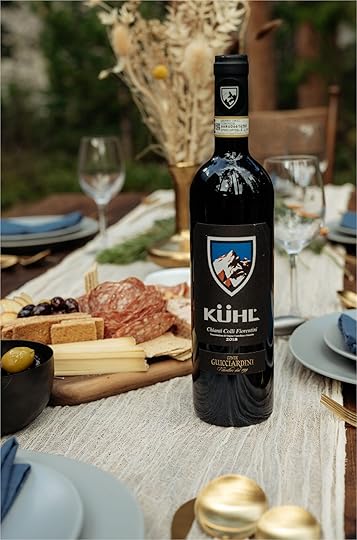
Photo courtesy KÜHL
The partnership between KÜHL and Guicciardi began not with grapes, but textiles, as the former began sourcing Italian fabrics from the latter nearly 30 years ago. In the late 1990s, Bernardo Guicciardini Calamai and KÜHL founder Kevin Boyle connected to do business making clothes. The Calamai side of Bernardo’s family has been in the textile industry for over 100 years, specializing in blending synthetic fibers with wool to create functional, sustainable fabrics for outdoor activities – and the Guicciardi side – his mother’s – had been making wine for some 800 years in Tuscany.
“Our family started a collaboration cause the Calamai side was well known for being a high-quality fabric producer in Prato, so was easy for Kevin and Bernardo to start a good business relationship that last since 20 years,” Bernardo Guicciardi told Matador via email. “While the collaboration was going on, turns out that our family are not just fabric producers, coming from Calamai family part with their roots in Prato, but also winemakers since 1199 from Guicciardini side that own Castello di Poppiano.”
The idea to partner on KÜHL-branded.wines for distribution in the United States came from the success of the fabric sourcing partnership. The pair of companies had developed trust and a good working relationship – and both were curious if merging wine with the traditionally beer-soaked outdoor community would work.

Bernardo and Fernandino Guicciardi, purveyors of a enturies-old Italian winemaking tradition. Photo courtesy theGuicciardi family.
The Guicciardini family’s legacy in winemaking is deeply intertwined with the rich history of Italian viticulture. Their journey began in 1199 in the Poppiano region of Italy, where they have been producing wine for over eight centuries, passing down their expertise through generations. Chianti is the iconic grape of Tuscany, and it’s fittingly the flagship wine in the KÜHL line.
At the heart of their winemaking tradition is Castello di Poppiano, one of Italy’s oldest independent wineries, which has remained family-owned and operated throughout its history. This steadfast commitment to their heritage is reflected in their meticulous approach to winemaking, where grapes are cultivated and processed entirely on the estate. This longevity means they’ve mastered the local terroir – a facet that makes the wine partnership with KÜHL unique. This is particularly true among outdoor-industry-focused wines, as others like Revelshine don’t have nearly the length of tradition.
Beyond historical significance, the Guicciardini family plays a vital role in shaping the identity of Tuscan wines, particularly Chianti, which is made predominantly from the region’s renowned sangiovese grape. The estate’s unique geographical features, including its southwest-facing vineyards and elevation of about 1,000 feet above sea level, create ideal conditions for cultivating high-quality grapes. Their ability to sustain a thriving wine business for centuries stems from their balance between honoring tradition and adapting to modern tastes – particularly among younger generations that aren’t consuming as much wine as older generations and aren’t as well-versed in the traditions. This enduring success and commitment to excellence made them a fitting partner for KÜHL, as both share a deep appreciation for independence, craftsmanship, and the adventurous spirit that defines mountain culture – oak casks are quite adventurous, after all.
KÜHL now offers both a red and a white wine crafted to embody the rich traditions of Italian winemaking. The KÜHL Chianti Colli Fiorentini Red Wine, a classic Tuscan red known for its robust flavors and aromatic profile. This was the original wine for the partnership, with notes similar to what wine aficionados expect from an Italian red – a heavier taste that pairs well with meats and pasta. A Vermentino now available for those who prefer a crisper, lighter white wine. The Vermentino, according to its makers, leaves notes of wildflowers and fruits with a light finish that pairs well with seafood.
“Both companies are proud to be privately owned and independent with the same task, to provide our customers the highest quality products,” Guicciardi says.
The wines can be ordered online and shipped to most states around the country. In Utah, the wines are available in many state liquor stores, and in New York, can be ordered in advance and then picked up in person at Eataly NYC Flatiron. Each bottle costs about $24.99, though shipping and delivery costs vary by state.
Tips for an adventurous toast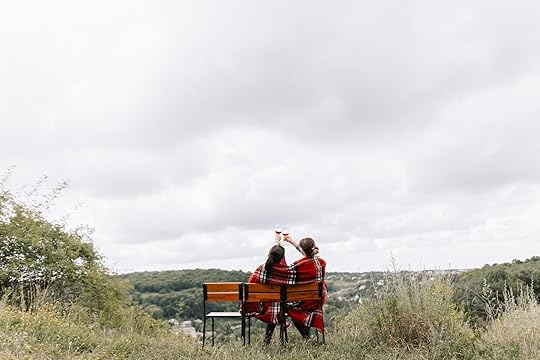
Photo: Jbondart/Shutterstock
That’s quite an impressive history. You’re right to be thirsty. It’s fitting to drink wine developed by outdoor lovers in the outdoors, of course, which can take a bit of planning to properly execute. Bringing a bottle of wine on a hiking adventure can elevate the experience, but it requires some planning to ensure a smooth and enjoyable moment at the summit. Don’t forget to pack a lightweight corkscrew. Temperature is also a factor – you don’t want to the wine to warp in the heat – so keeping your wine in an insulated bottle or cooler sleeve can help maintain its dignity. On this note, if you open the bottle before heading out, be sure to seal the wine tightly in its travel container and drink it before too long. A bit of air helps bring out the flavors of a wine – too much air can spoil it.
To transport the wine safely, wrap a glass bottle in a padded sleeve, a ski sock (clean, preferably, so as to avoid that foot funk smell), or a piece of clothing to prevent breakage in your backpack. Secure it near the center of your pack to balance the weight and minimize shifting. When it’s time to enjoy the wine, find a comfortable, scenic spot, and bring along collapsible tumblers for easy sipping.
One thing works in your favor when brining wine on an outdoor adventure – red wine, in particular, pairs well with trail-friendly foods like cheese, nuts, or dried meats. Energy bars aren’t too far off the cuff here, either.
Most importantly, always follow Leave No Trace principles by packing out your empty bottle, cork, and cups. This is a good excuse to finish the wine – the views from wherever you pop the cork will be that much better. 
White Peacocks and Baroque Splendor Make the Italian Island of Isola Bella a Living Theater
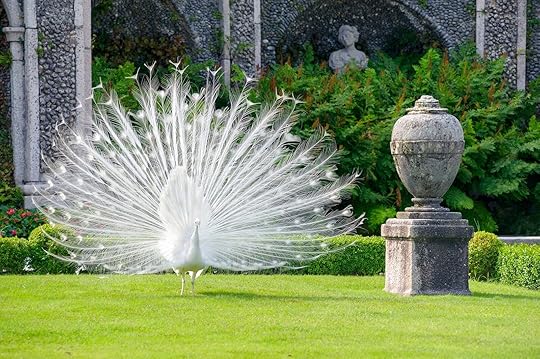
Rising from the waters of Lake Maggiore like a dreamscape stitched in stone and bloom, architecture, art, and nature conspire in a grand baroque spectacle on the island of Isola Bella. And at its most enchanting moments, the scene belongs not to statues or terraces, but to the slow, deliberate glide of a white peacock across a balustrade.
Here, on one of Italy’s most storied lake islands, fantasy takes wing — quite literally.
View this post on InstagramA post shared by Visit (@visit)
Once a craggy fishing outpost inhabited by churchmen and vegetable growers, the aristocratic Borromeo family transformed Isola Bella in the 17th century as a floating palace and garden retreat that could rival Versailles. The construction of Palazzo Borromeo, with its frescoed salons and shell-lined grottoes, set the tone. But it was the design of the formal baroque gardens, climbing in 10 dramatic terraces to form a truncated pyramid, that turned the island into a destination on bucket lists to this day.
By the 18th and 19th centuries, Isola Bella had become an essential stop on the Grand Tour, drawing European nobility, writers, and artists to its shores. Alongside Isola Madre, its sister island, it helped put the lakeside town of Stresa on the map as a cosmopolitan retreat — a vibe that still lingers today.
More than half the island is dedicated to gardens — an extraordinary feat of landscaping built on artificial terraces that seem to hover above the water. This horticultural marvel seduces visitors not just with its visual drama, but with a rich layering of seasonal color. Spring brings camellias, rhododendrons, and roses; summer follows with bursts of citrus and rare subtropical blooms made possible by the lake’s protective microclimate.
At the heart of it all is the Teatro Massimo, a sculptural crescendo of obelisks, fountains, shell-lined niches, and statues that feels more opera set than garden centerpiece. The experience is multisensory. Birdsong mingles with the hush of fountains, flower-scented breezes catch between limestone colonnades. Amid all this splendor, it’s often the unexpected appearance of a certain bird that defines visits.
The white peacocks of Isola Bella: Emissaries of enchantmentNothing captures Isola Bella’s sense of enchantment more vividly than its white peacocks, roaming freely among terraces and topiary like feathered ghosts.
Contrary to popular belief, these birds are not albino, but leucistic — a genetic condition that strips their feathers of pigment while leaving their eyes and skin unaltered. This gives them a surreal, snow-white appearance, with iridescent feathers that shimmer in soft light. Born yellow as peachicks, they gradually fade into ivory elegance.
These birds are almost always of the Indian peafowl species (Pavo cristatus) — a species revered not only for its physical beauty but for the cultural symbolism it carries. In Christian tradition, the white peacock has been associated with Christ’s resurrection and purity. In Buddhism, it embodies nirvana, untouched by the material world. And in Hinduism, it’s a bringer of luck, prosperity, and spiritual clarity.
In secular symbolism, the white peacock often stands for purity of mind and spirit, an apt metaphor for a place so untouched by time and so carefully designed to elevate the senses.
While the statues may be fixed in marble poses, the white peacocks are the island’s living sculpture. Guests often pause mid-tour to watch them glide across the Teatro Massimo or perch beneath a camphor tree.
It’s this interplay between cultivated beauty and natural wonder that gives Isola Bella its staying power.
If you goGetting there: Isola Bella is accessible by regular ferry service from Stresa, with additional routes from Baveno and Verbania.What to see: Entry tickets include access to Palazzo Borromeo, with its opulent interiors and shell-studded grottoes, as well as the full garden grounds.Best time to visit: Late spring through early summer is prime bloom season, though the gardens and peacocks are a delight from April through October.Nearby sights: Combine your visit with Isola Madre’s English-style botanical gardens, or take a lakeside walk through Stresa’s elegant Belle Époque villas. More like thisFood + DrinkWhat It's Like to Go Truffle Hunting in Italy With Tuscany's 'Giulio the Truffle Hunter'
More like thisFood + DrinkWhat It's Like to Go Truffle Hunting in Italy With Tuscany's 'Giulio the Truffle Hunter'
No Passport, No Problem: Caribbean Travel Comes Easy at This USVI Resort

A sea breeze waved my ponytail like a flag as I watched a group of grey pelicans take turns flying into the air before plunging straight down into the azure waves of Water Bay on the Caribbean island of St. Thomas. If they tipped their heads back after surfacing, I knew they caught a fish. This playful scene was repeated over and over as I walked along the palm-tree-lined beachfront of the island’s Margaritaville Vacation Club.
St. Thomas is the second largest (and second smallest) of the three main US Virgin Islands. The capital city, Charlotte Amalie, is a busy cruise ship port, but the island has lots of coves and bays that are hidden from the bustle. That’s where you’ll find Margaritaville Vacation Club St. Thomas — perched on Water Bay on the island’s east side, miles from the capital.
All suites, all the time: The rooms at Margaritaville Vacation Club St. Thomas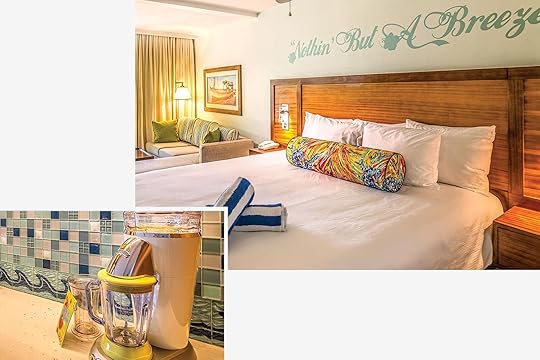
Photos: Margaritaville Vacation Club St. Thomas
Suites are the name of the game at Margaritaville Vacation Club St. Thomas. Every guest building contains a combination of studio, one-bedroom, and two-bedroom suites. The resort is divided into two areas: the bayside area — where I was, surrounding the pool and facing the beach — and a hillside section overlooking Water Bay. Each building is named after a Jimmy Buffett song. Mine was Havana Daydreamin’.
A ceiling fan recreated the island breeze inside of my first-floor studio, which featured a king-size bed, a living area with a combination sofa and chaise lounge, a dining table for two, and a kitchenette on the opposite wall. A Margaritaville-branded blender designed for frozen drinks took up a sizeable chunk of the kitchenette counter. Appropriate.
Decorated with framed Jimmy Buffett album covers, my suite had ample space to spread out, which I needed for my snorkeling gear. One unique room feature was the drying rack across from the large bathroom that included two beach towels ready for use. I did a lot of swimming and snorkeling during my stay, so the drying rack came in handy.
But my favorite feature of the suite was the patio, a tranquil spot where I enjoyed a bagel and coffee each morning. The patio had a small table with two chairs and a giant leafy hedge blocking most of the view. That might be a dealbreaker to some, but for me, it provided a buffer between the pool area’s music and frolicking families and kept the patio cool all day long.
Back inside, a sign on the nightstand informed me that the area is also turtle habitat. At night, the resort dims the lights around the property to protect nesting areas and asks guests to do the same by turning off their lights or using the blackout curtains provided in every room.
Live music and sunset sails: Activities at Margaritaville Vacation Club St. Thomas
Photos: Margaritaville Vacation Club St. Thomas
Margaritaville Vacation Club St. Thomas has several on-site amenities — a dive shop, a combination sundry store, a deli, a coffee shop, and a fitness center among them — but a big part of its focus is on providing guests with experiences.
To start, the hillside suites have their own pool with a swim-up bar and sweeping views of Water Bay and nearby islands. Guests have the option to climb a long flight of steps to reach the hillside pool — which I used as my daily workout — or take a shuttle cart. (Shuttle carts are available to get around the property, but I found the grounds easily walkable and enjoyed spotting tiny lizards, large iguanas, hens, roosters, and baby chicks as I strolled along.)
Another cool resort area is the outdoor Six String Music Stage overlooking the beach. A small courtyard with rows of colorful Adirondack chairs faces a small stage where different local musical acts perform each night in a range of genres. My first night featured a reggae band, the next a DJ spinning pop hits, and the last night was an acoustic guitarist who not only sang songs by Jimmy Buffett but also Jack Johnson and Zack Brown.
One of my favorite experiences at Margaritaville Vacation Club St. Thomas was a sunset cruise from the resort’s pier. Before boarding the 50-person Snorkel Cat catamaran, we were told to put our shoes in a basket because it was a barefoot cruise. As we boarded, we were greeted with glasses of Champagne. As we sipped our bubbly, Captain “Big Tuna” gave a safety talk, so we were all prepared for the two-hour sail.

Photos: Carrie Dow
Crew members Lauren and Sean were also our bartenders because the sunset cruise included an open bar. They served two signature Caribbean cocktails: Rum Punch and Painkiller. Simple mixed drinks and wine were also available. Big Tuna added that cans of beers (Bud Light and “Bud Heavy”) were available in a self-service cooler by the bar. The crew then passed appetizers like bruschetta and shrimp cocktail once we got underway.
First, we sailed through the Windward Passage past the hillside mansions of St. John, the neighboring US Virgin Island. We then turned into the Atlantic Ocean around a small resort island called Lovango where Big Tuna pointed out wild goats climbing the rocks. As the sun dropped into the sea, he suggested that everyone look behind the boat to see a few wispy clouds turn light pink and orange to everyone’s delight.
Champagne Sunset Sails are offered daily, and the Snorkel Cat is also available for snorkeling tours, which you can book at the Margaritaville dive shop or online.
Noshing Buffett-style: Dining at Margaritaville Vacation Club St. Thomas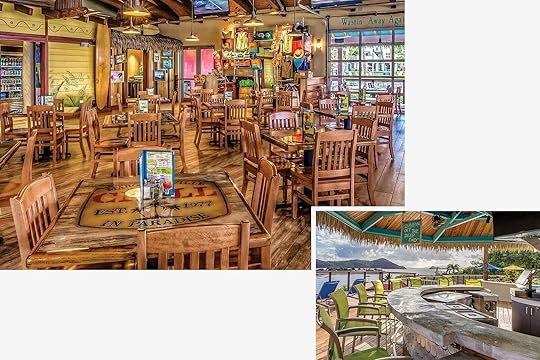
Photos: Margaritaville Vacation Club St. Thomas
Jimmy Buffett’s Margaritaville is the resort’s only full-service restaurant. It’s helmed by Chef Burton who originally trained at the high-end Caneel Bay Resort on St. John. On my first night at the resort, my group enjoyed Caribbean egg rolls, jerk BBQ chicken, and chocolate lava cakes for dessert. My other meal at Margaritaville Restaurant was the famous “Cheeseburger in Paradise” with a choice of a single or double beef patty cooked to medium perfection and topped with American cheese, lettuce, and tomato.
As for drinks, what would Margaritaville be without margaritas? We were able to talk our server into creating a “flight” for us. We each ordered a different style of margarita and had the bartender divide them into four sets of four small glasses. They even put salt on the rims for us.
Beyond Margaritaville Restaurant, the resort has three casual walk-up drinking and dining spots (so frozen concoctions are never far away) — the LandShark Bar & Grill next to the restaurant facing the beach, the 5 o’Clock Somewhere Bar next to the bayside pool, and the License to Chill Bar & Grill at the hillside pool.
Exploring the island: Things to do near Margaritaville Vacation Club St. ThomasCoki Beach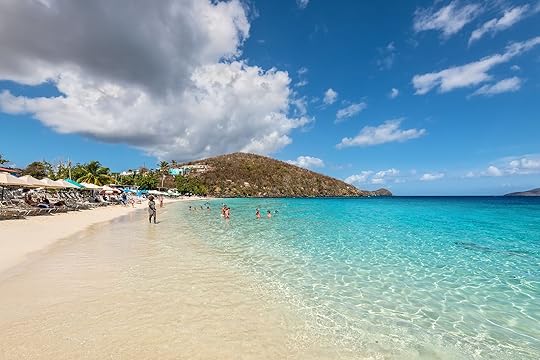
Photo: byvalet/Shutterstock
Occasionally, the resort’s beachfront gets bigger waves that are not ideal for young children or non-swimmers. However, Coki Beach, a large public beach at the end of the resort’s peninsula, is more protected. It’s a short walk away, but you also have the option to ride resort shuttles to and from the beach. Along with soft sand and crystal-clear turquoise water, Coki Beach has lounge chairs and umbrellas for rent, two small restaurants, scuba and snorkel rentals, souvenir shops, and restrooms.
Island excursions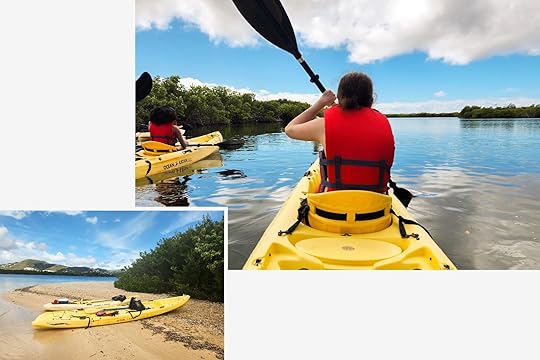
Photos: Carrie Dow
The concierge at the Margaritaville Vacation Club St. Thomas has plenty of recommendations for island activities. My favorite was the Virgin Islands Ecotours kayak tour in Cas Cay only a 15-minute taxi ride away. Our guide, Gabby, took us on kayaks through secluded mangrove bays, pointing out wildlife like the Cassiopeia (or “upside-down”) jellyfish, a creature that lives on the bay’s bottom. The jellyfish looked like coral from the surface, but when Gabby picked one up and flipped it over, you could see the its mouth and gelatinous body.
After paddling through a narrow channel with a mangrove canopy, we paddled across another small bay, stopping at a tiny beach with a canvas-covered picnic area. It was swarming with hermit crabs scavenging for food dropped by previous visitors. There were so many that their shells made click-clack sounds as they bumped into each other.
Next, we snorkeled in the clear bay. Gabby led us to an inlet with a giant school of silver and yellow mutton snapper just below the surface, along with a colorful array of smaller fish like blue tang, damselfish, trunkfish, and the black-, white-, and yellow-striped sergeant major.
Downtown Charlotte Amalie
Photo: Carrie Dow
For a day in downtown Charlotte Amalie, the resort has a “shopping shuttle” that can take guests into town. The historic port has dozens of shops selling duty-free clothing, watches, artwork, and jewelry along walkable streets and alleyways with names like Palm Passage.
After indulging myself with a beautiful giclee (a type of digital print) of pelicans by local artist Jonna White, I met up with my travel mates at Gladys’ Cafe for lunch. The cafe was hidden in an alleyway between a watch store and a coffee shop inside a historic Dutch-era building with brick walls and tall archways on both sides of a long bar. I kept things light with a tuna salad sandwich because I knew we were coming back to Charlotte Amalie for dinner.
After lunch, we searched for the 99 Steps, a historic brick stairway built by the Danish in the 1700s. We used our phones’ GPS to find it as there weren’t any signs or markers. Located near the Galleon House hotel, the steps were being refurbished with some of the bottom rows torn out; however, the upper half was finished, so we carefully walked to the top to take in the views.
Charlotte Amalie is also famous for its jewelry stores. The city’s oldest is Cardow Jewelers on Dronningens Gade. Opened in 1954 and run by third-generation family members, the jewelry store recently opened a speakeasy bar called the Cardow Rum Room featuring the family’s bespoke Extra Virgin Rum at the back of the store. There, my group took a cocktail class where our guide, Daniel, not only explained how Extra Virgin Rum is made but also taught us how to make our own Rum Punch and Painkiller cocktails.
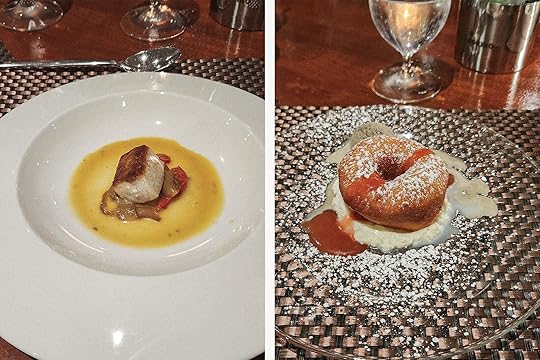
Photos: Carrie Dow
After a late afternoon break at the resort, we returned to Charlotte Amalie for dinner at Blue Eleven. Opened by Chef David “Benji” Benjamin, the restaurant has daily tasting menus that feature fresh local ingredients from the land, sea, and soil. Guests can choose between seven-, nine-, and 11-course tastings. We made a night of it by selecting the 11-course menu, which lasted over three hours. I especially enjoyed the jerk chicken and spicy plantains, pan-seared mahi mahi and conch, and the house-made dessert of a pillowy glazed donut with a dollop of espresso ice cream.
Getting to Margaritaville Vacation Club St. Thomas and around the islandBecause the US Virgin Islands are a US territory, no passport is required for American travelers, making St. Thomas ideal for a quick, easy tropical getaway.
St. Thomas’ Cyril E. King Airport has direct flights from the East Coast, including many less than four hours from these major cities: Miami, Atlanta, Charlotte, Newark, and New York City. Airlines with daily service include American, Delta, and United.
While taxis are available to get around St. Thomas, you can save time by booking a private shuttle or taxi online in advance. We used Big Love Taxi for all transfers. Margaritaville Vacation Club St. Thomas is about 30 minutes from the airport.
Rental cars are also available, but they drive on the left in the US Virgin Islands. Steep hills with narrow roads add to the degree of difficulty. If you would prefer to rent a car, Margaritaville Vacation Club St. Thomas offers free on-site parking. 
You Can Actually Stay at These 5 Hotels Featured in ‘The White Lotus’ Season 3
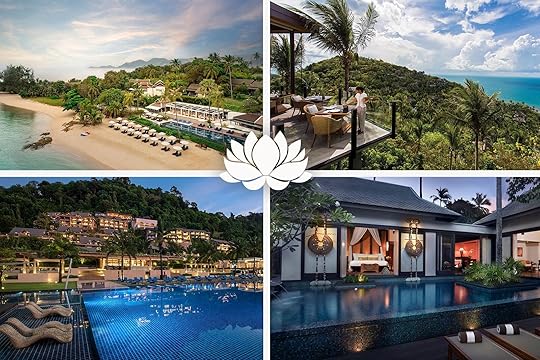
The White Lotus plunges viewers into the opulent, yet often troubled, world of the ultra-wealthy through the setting of a breathtakingly luxurious resort. The formula is simple: take a group of privileged individuals, place them in a paradise setting, and watch as their personal dramas, societal anxieties, and cultural clashes unfold.
The show’s creators have a knack for selecting properties that epitomize exclusivity and aesthetic perfection. It’s no coincidence that the series has forged a strong relationship with the Four Seasons brand, which is known for its unwavering commitment to luxury. In many ways, the resorts are characters in themselves, shaping the narrative and reflecting the inner turmoil of the guests.
The third season, set in Thailand, expands beyond a single resort — unlike the first season, filmed almost entirely at the Four Seasons Resort Maui at Wailea in Hawai‘i, and the second at the Four Seasons San Domenico Palace in Taormina in Taormina, Sicily — using multiple locations to create the fictional White Lotus experience.
While the Four Seasons Resort Koh Samui serves as the primary setting, other luxury properties have been cleverly woven into the fabric of the narrative. That raises the question: Can you actually experience these locations for yourself? The answer, thankfully, is a resounding yes.
Check out Matador’s White Lotus-themed accommodations guides: 6 Affordable Wellness Retreats in Thailand for a ‘White Lotus’ Experience This Estate in ‘White Lotus’ Season 3 Is Available on Airbnb Book the Thai Beach Resort Where ‘The White Lotus’ Was Filmed Before It Sells Out Channel Your White Lotus Fantasy at These Thailand Airbnbs Stay in the Sicilian Hotel Where Season 2 of ‘White Lotus’ Was Filmed 6 Thailand Hotels that could be used for ‘The White Lotus’ Season 3We hope you love The White Lotus resorts we recommend! Just so you know, Matador may collect a small commission from the links on this page if you decide to book a stay.
Four Seasons Resort Koh Samui Photo: Four Seasons
Photo: Four Seasons Photo: Four Seasons
Photo: Four Seasons Photo: Four Seasons
Photo: Four Seasons Photo: Four Seasons
Photo: Four SeasonsMost of this season’s drama unfolds at the Four Seasons Resort Koh Samui. Cast members stayed on-site during production, and the resort was closed to other guests for two months during filming.
Situated on the island’s northeastern coast, this 40-acre, five-star resort is not for the tight-fisted. Matador Network editor Suzie Dundas recently looked into what it would cost to vacation like a White Lotus guest, and it’s not cheap, to say the least.
The resort’s design draws from traditional southern Thai architecture, with thatched roofs and indoor-outdoor spaces framed by jungle foliage, hundreds of coconut trees, and the cerulean hues of the Gulf of Thailand. The 60 pool villas and 11 private residences cascade down a lush hillside, each with its own infinity pool and panoramic views of the private beach and ocean. At night, glowing lanterns peek through the foliage. The private pool villas (specifically Residence 9, a multi-level private villa with two infinity pools) and the resort’s private beach are heavily featured in the first three episodes of the third season.
Dining experiences at the resort include the on-the-beach PlaPla, which serves dishes such as lobster hummus and sea bass ceviche with passion fruit, and the Michelin-recommended Koh Thai Kitchen, which celebrates regional southern Thai cuisine (the slow-cooked wagyu beef cheek massaman curry is, reputedly, next-level good). For pre-dinner cocktails, there’s CoCo Rum above the pool and the Rum Vault, or guests can simply sit back and order a Thai G&T on their private patio.
The Secret Garden Spa is as pretty as you’d expect. There are five treatment rooms and a long menu of traditional therapies, such as Thai foot reflexology and four-handed massages using oils infused with herbs from the resort’s “secret garden.” The resort also offers a range of recreational activities, both complimentary and paid extras. There are snorkeling tours with a marine biologist, Thai language classes, talks about coral, tennis, and Muay Thai boxing. There are also more contemplative practices like guided sundown meditations, which some of the characters in the series could certainly benefit from.
A Four Seasons Resort Koh Samui representative says over email that there has been a noticeable increase in the number of people interested in the resort, and Thailand’s Tourism Authority anticipates a 20 percent rise in tourism due to the show.
Book The Four Seasons Resort Koh SamuiAnantara Mai Khao Phuket Villas Photo: Anantara Hotels and Resorts
Photo: Anantara Hotels and Resorts Photo: Anantara Hotels and Resorts
Photo: Anantara Hotels and Resorts Photo: Anantara Hotels and Resorts
Photo: Anantara Hotels and Resorts Photo: Anantara Hotels and Resorts
Photo: Anantara Hotels and ResortsThe Anantara Mai Khao Phuket Villas, located in Mai Khao just below the island’s northern tip, plays a pivotal role — particularly in scenes featuring Belinda Lindsey (Natasha Rothwell), the spa manager from Season 1. The resort’s Wellness Sanctuary Spa, where Belinda’s scenes were filmed, overlooks a lagoon filled with blooming lotuses. The six treatment rooms offer a haven within a haven, with therapies ranging from Thai warrior massage and chakra crystal balancing to sound bowl healing.
Like the Four Seasons, this resort’s design is inspired by traditional Thai architecture, with teakwood accents, finely carved embellishments, and sacred monkey statues. Accommodations are spread across two areas with 70 suites and 30 one-to-four bedroom Pavilion Pool Villas.
Book Anantara Mai Khao Phuket VillasAnantara Bophut Koh Samui Resort Photo: Anantara Hotels and Resorts
Photo: Anantara Hotels and Resorts Photo: Anantara Hotels and Resorts
Photo: Anantara Hotels and Resorts Photo: Anantara Hotels and Resorts
Photo: Anantara Hotels and Resorts Photo: Anantara Hotels and Resorts
Photo: Anantara Hotels and ResortsAnother Anantara property featured in the third season is the Anantara Bophut Koh Samui Resort. The resort was the backdrop for several key scenes, including those set in the hotel lobby, security station, tree-lined resort entrance, employee parking lot, and the jewelry store.
The resort’s luxurious beachfront location and tropical gardens are the perfect setting for the show’s intricate plotlines. Due to the popularity of Koh Samui, the island can evoke some feelings of sensory overload. The Anantara Bophut Koh Samui is a breath of fresh air, a quiet retreat despite its proximity to the lively Bo Phut’s Fisherman’s Village. Rooms and suites are drenched in natural light and surround a palm-shaded pool. There are exceptional restaurants in the village and a famous night market three times a week for street food bites, and the resort offers a welcome departure from the stuffy fine dining establishments often found on the island. Thin Tai serves modern Thai cuisine, and Guilty offers South American comfort dishes like potato croquettes with truffle mayonnaise and Argentinian-style lamb chops.
Book Anantara Bophut Koh Samui Resort NowAnantara Lawana Koh Samui Resort Photo: Anantara Hotels and Resorts
Photo: Anantara Hotels and Resorts Photo: Anantara Hotels and Resorts
Photo: Anantara Hotels and Resorts Photo: Anantara Hotels and Resorts
Photo: Anantara Hotels and Resorts Photo: Anantara Hotels and Resorts
Photo: Anantara Hotels and ResortsThe Anantara Lawana Koh Samui Resort also played a role in the third season, with its Singing Bird Lounge used for the bar scenes — you might remember it from the scene where Chelsea (played by British actress Aimee Lou Wood) meets retired model Chloe (Charlotte Le Bon). The lounge has a treehouse-style design and panoramic ocean views. Its name comes from the traditional bird-singing contests on Koh Samui where trained zebra doves, known locally as nok khao chawa, are judged on their ability to imitate other bird songs.
Anantara Lawana offers the “Glimpse of White Lotus” package. Set in the lounge, guests can choose from a curated list of cocktails inspired by the series including the Anantara White Lotus mirage, a gin-based drink with floral notes; Mook, a tequila cocktail named after the character of the same name; and gaitok, a mezcal-based concoction. After cocktails in the lounge, guests can indulge in an eight-course tasting menu: either “Embers of Earth & Ocean,” a seafood and meat-focused menu, or “Roots of Earth & Bloom,” a vegetarian alternative. The dining experience includes engraved keepsakes and a hush-hush exclusive gift.
The resort’s location at the northern edge of Chaweng offers a balance of accessibility and seclusion. is within walking distance or a short tuk-tuk ride away. Behind the resort’s walls, there’s a tranquil, elegant atmosphere. The resort features a collection of villas and rooms, including two-story houses and standalone pool villas, creating a private environment for guests. The beachfront bar and restaurant terrace foster a more communal environment.
Book Anantara Lawana Koh Samui Resort NowRosewood Phuket Photo: Rosewood Hotels
Photo: Rosewood Hotels Photo: Rosewood Hotels
Photo: Rosewood Hotels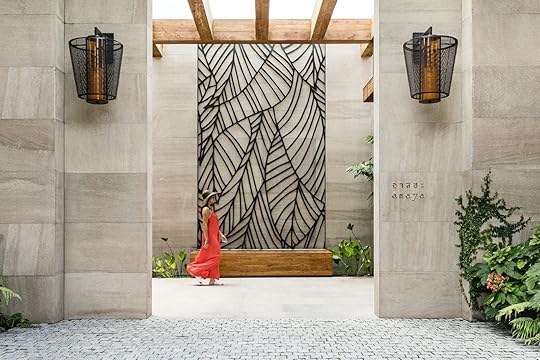 Photo: Rosewood Hotels
Photo: Rosewood Hotels Photo: Rosewood Hotels
Photo: Rosewood HotelsRosewood Phuket‘s Ta Khai restaurant was used for dinner scenes because the Four Seasons restaurant area was too dark to film at night. Situated on Emerald Bay, a 60-minute drive from Phuket International Airport, the Rosewood feels a world away from the island’s more commercial areas.
The seafood restaurant is styled to resemble a fisherman’s village, and has been a destination restaurant on the island for over a decade. The menu is based on the day’s catch, with dishes like tod mun goong (fried shrimp cakes and pickled vegetables with a sweet plum sauce) and pla kapong neung manao (steamed snapper fillet dressed in lime, garlic, and chili). Focusing on local ingredients and experiences, the resort’s “A Sense of Taste” program collaborates with Thai producers like Bah Mi for noodles and Big Bee Farm for honey. There are also food-based excursions like yacht fishing trips.
As one of the island’s most expensive builds, the Rosewood Phuket offers 71 over-the-top pavilions and villas, each designed to integrate with the surrounding jungle landscape. These accommodations, ranging from Garden Pool Pavilions to expansive Beachfront Pool Villas, feature private pools, gardens, and outdoor bathing areas. Eco-friendly roof gardens adorn many units, while interiors showcase contemporary design with local materials, Thai artwork, and thoughtful amenities like cocktail-making kits and touch-button blinds. 
What It’s Really Like to Travel to Iraq as a Westerner Right Now

In a world where headlines often paint countries in broad strokes, Dutch filmmaker Reinier van Oorsouw wants to offer an alternative — particularly in places many Westerners wouldn’t typically consider visiting. His latest film, produced in partnership with Matador Network, is an exploration of Iraq.
“Our perception of the world is very different than reality,” van Oorsouw says. Traveling to places not typically popular with Western tourists is an opportunity for cultural understanding, rather than just a touristic experience. It’s all about nuance, he says, including nuance in risk assessment. “You can never eliminate a risk,” he adds. But if you can book a car for a road trip relatively easily, finding accommodations on the go, that passes van Oorsouw’s internal evaluation of what’s safe.
His trip took him to Baghdad, Al-Hillah (the site of the former city of Babylon), and Iraqi Kurdistan, an autonomous region within Iraq. Kurdish people live in Iraq, Iran, Türkiye, and Syria, though they have no official country. Fights for recognized independence continue in various regions, but in Iraq, the Kurdistan region has special status with a high level of autonomy, including its own parliament, president, and security forces.
The film starts on March 19, 2003, when then-President George W. Bush announced the start of the military invasion of Iraq during a televised White House address. The previous year, Bush had signed the Authorization for Use of Military Force Against Iraq Resolution of 2002, more commonly known as the “Iraq Resolution.” America’s on-the-ground presence lasted until December 2011, when the country’s final troops were removed. More than 4,400 American service members were killed, and between 300,000 and 500,000 Iraqis were killed or died from war-related incidents.
“When the war was going on in Iraq, I was a young teenager,” van Oorsouw says. “So understanding what went on at the time was very foreign to me. I had not really traveled. Even in the Netherlands I was fed the media and saw things happening but didn’t understand why.”

Photo: Reinier van Oorsouw
This isn’t van Oorsouw’s first film with Matador Network exploring a country generally considered off-limits for Western travelers. In 2018, van Oorsouw and Matador worked together on a similar project centered on Iran. It was a natural next step for Van Oorsouw, who got his start filming travel stories around the world with Lonely Planet. In 2008, he started Beyond Borders Media, which has grown into a communications agency for developmental work and human interest stories, frequently working with NGOs and the United Nations.
Van Oorsouw lives in Lima, Peru, with his wife and their two-year-old child. Daycare in Peru is much better than in van Oorsouw’s native Netherlands, he says, and Peru’s weather, food, and backyard are certainly welcome, too. “My interest in the world comes from traveling, understanding, and demystifying other cultures. What we’re taught in school is usually black and white — one thing or the other but nothing in between,” van Oorsouw says. “This travel opened my eyes to see a range of colors, and every time you dive into a new adventure, you come back with answers but way more questions as well.”

Majed Amer, translator who grew up in Baghdad and moved to the Netherlands during the war. Photo: Reinier van Oorsouw
He traveled with cameraman Jerry de Mars and friend and translator Majed Amer, who used to live in Baghdad but moved to the Netherlands during the war. Van Oorsouw’s film covers cities, towns, and historic sites, including Saddam Hussein’s graffiti-covered and cavernous abandoned palace, as well as the remains of the ancient city of Babylon. It’s more than sights and views. Local food, spices, teahouses, and coffeehouses were an important part of his experience and provided a chance to have deeper, spontaneous conversations with locals.
“Our perception of the world is very different than reality,” van Oorsouw says. “I would say I’m a nuance seeker in this case, and I’m mainly trying to amplify the local voices. I can pretend that I know a place if I go on a road trip for a week or two, but that’s only an impression — it’s one side. It’s still fed by media impressions that I have. It’s a conversation starter, and I’m hoping to show something else than [what] the traditional media show you: that there are people there trying to make the best out of their lives. Of course there are extremes in places, but there are in the United States as well.”
We caught up with van Oorouw to learn more about what it’s like to travel to Iraq as a Westerner right now, and what travelers need to know before going.
This interview has been edited for length and clarity.
What goes through your mind when deciding to visit a place typically considered “dangerous” and “not a tourist destination?”There are places with a higher risk where [when] I go with my “gringo” face, it’s obvious that I stand out. For places like Iraq, Iran, Afghanistan nowadays, places like Venezuela for instance, you can go there, there’s no wars. But there is a type of danger. So if you go to a place like this, identify the danger. How can I reduce the risk? If I reduce it as much as possible, am I comfortable enough to go? But you can never eliminate risk. If you don’t want to take that risk, go on a cruise in the Caribbean. You’ll be fine. Or maybe the cruise sinks.
How do you make that calculation of whether somewhere is safe enough to visit?The whole idea behind this series is to go in without any form of preparation other than a ticket, visa, and renting a car. My idea is if you can freely do a road trip, navigate as you go, find somewhere unplanned to stay in the evening, and manage that relatively comfortably, then I feel the country is not that bad. That’s the threshold. This was certainly the case for all that I’ve seen in the Kurdistan part of Iraq, but also in the Iraqi part of Iraq.

A local who sings for the camera in the film. Photo: Reinier van Oorsouw
Late at night driving around was perfectly safe. There’s a lot of checkpoints, and the people who work at these checkpoints will raise a few eyebrows of why where are three Westerners driving around and they think we’re a bit loco. But if you approach it with a smile, if there’s nothing you’ve done wrong, if you know that there are no restrictions and your paperwork is all okay, it’s rare to get into trouble.
Were there any instances that made you pause on this trip to Iraq?While we were in Kurdistan, there were some security issues. On the way through this mountain pass to this town, we got a notification from the Dutch consulate in Kurdistan that there was a drone strike by either Turkish or Iranian forces in exactly that town where we were going. I thought, okay, it’s like rain that has already fallen. So the chance that we get hit by another drone strike is almost zero, it won’t come our way again. But is it good that an hour after there’s a drone strike, there are three white guys showing up; “hey guys, how are you doing?” So there’s the sensible thing of turning around and taking another route.
I also understand that for a lot of people, hearing the words “drone strike nearby me” is already a motive not to travel. But in there is a nuance.
What can the average traveler take away from that?If you want a vacation, I would say don’t go to Kurdistan or the whole of Iraq. If you want an adventure, if you know your way around, if you’re a bit of a seasoned traveler, you can do it. Just understand what you’re going to. If you’re not all about beaches and sipping piña coladas at sunset, but have an exploring mindset and want to learn about a place through the eyes of local people, these are very interesting times and you can do so in a way that is relatively safe.
It’s travel with an interest in understanding what’s going on in the world. I wouldn’t even call it tourism, but cultural understanding.

Photo: Reinier van Oorsouw
Does seeing everyday life in Iraq and other places you’ve been change how you think about other places?There’s almost always a rush to explain the exact opposite from what you’re used to. Understanding and trying to have empathy with other points of view will help, at least they help me, bring more understanding of life and different cultures.
I’ve seen my fair share of guns in Iraq, because they’re out there as well. It’s just that people don’t wave them around and it’s only guards, police, or army who usually carry guns. I don’t want to hit the infamous topic of school shootings in the US, but I don’t think the words “school shooting” exists in Iraq.
If you come in as an outsider, everything seems foreign. But if you travel more and understand more of another place, you take that knowledge and you start to reflect it on the place where you’re from.
A big part of your experience involved meeting with locals, often by happenstance. What was that like?People come up to you in the streets, especially if you walk around with a camera, and ask where you’re from. We had that on various occasions. Not everybody will talk to you in this manner, but people there with an open mind, they see travelers coming in as a chance to interact with people from other cultures.
It feels like a lot of the public perception about what’s dangerous revolves around politics.The state of politics always affects a “dangerous” place because usually the source of danger comes through a political conflict — a ruler turning against their people, a rebel group trying to liberate a country (from their perspective). Usually politics or religion. Politics brings a difficult state for people, from pickpockets to kidnapping to fighting between factions. These are the symptoms you see.

Photo: Reinier van Oorsouw
Right, and the government is not necessarily of the people.That’s exactly what I try to show. The context is always political or religious, but I want to see the people who, you know, think differently and have their own lives and what drives them. That is very much the thing that I want to highlight.
The region is one of the cradles of civilization and agriculture. How did that history play into the experience that you had? Going to the ancient parts of Babylon must have been something.By chance, there was this group of local architects who were there. We started talking to them randomly and they were restoring parts of buildings with ancient methods. It really shows you how fragile a place like this is if it’s not well kept. This identity of Babylon is something for people from Iraq to be really proud of, you know. They had an empire here thousands of years ago. If this is safeguarded and preserved, this is a great thing they can look to as a united factor.
One of the places you went was Saddam Hussein’s palace that was never completed. What was that like?This abandoned palace is on a hill that overlooks the ancient part of Babylon along the Euphrates River. Between the palm trees, the sun is shining. It’s a beautiful place. It also feels a bit arrogant to think like, “Hey, I’m the next ruler of Iraq. I have to plan my legacy here next to this ancient civilization.” Putting yourself out there doesn’t feel right to me as a humble Dutch person. But this place is, of course, loaded with history. You’re walking through the corridors that would have been his home, had it been finished in time.
Now, it’s this place where local people go and visit. The walls are full of graffiti. There’s no windows, no furniture. Just empty hallways in this megalomaniac building. To me, it symbolizes how quick and ego can be broken down. Everything in life is fragile. You will die eventually, I will die eventually. It’s the only guarantee we have in life. We are trying to make the most out of it in our lifetimes and I’m guessing he did the same.
In addition to the important sites, you mixed it up in local markets and restaurants. How did those food experiences play into the trip?The taste of the Middle East has different herbs, spices, smells, tastes. The traditional food in every country is made by what’s from around there, and people in Iraq have had very different resources in different times.

Photo: Reinier van Oorsouw
You have teahouses, the ways coffee is made, how bread is made. The fresh produce they use, from the vegetables and the herbs to the spices. Diving into other food cultures is very enriching for me. The older I get, the more demanding my tongue and my stomach get. So I’m always trying to find new things that open my palate more.
I’m a coffee addict, so tasting different types of coffees is always a priority, and I try to take a few kilos home for personal use. Same goes for tea. I try to take some herbs, spices, dried fruits. Once you start to understand what other basic ingredients people are using, it’s nice to experiment a bit at home with it. I’m not at the chef’s standards of Iraqi cooking, but I’m just doing my best to make my own versions and share this with my friends because through these food experiences, you can let other people travel in a way to places that they won’t likely visit.
I’ve always thought of food as one of the best doors into culture.People will always be interested in food. We all eat every day. This is one of the ways to really indulge yourself, because in Iraq and the Middle East in general, the spices and how a meal is approached on a daily basis is so different to me coming from a country like the Netherlands, where the menu traditionally has been relatively basic. There’s a lot to learn. The Dutch robbed all the spices and herbs from around the globe, and we’ve never tried to use them. I think the Dutch are the OGs of don’t get high on your own supply.
If you go to everything between Türkiye, Tajikistan, and out to Bangladesh, there’s a similarity. What is very much at the surface are the landscapes. If you cross the border from Iran to Iraq or Iran to Afghanistan, you see why there are borders: gradually the landscape changes, but within that the base ingredients are often the same, but used differently from country to country.
I’ve been in Pakistan, Tajikistan, the country of Georgia, and Türkiye, where they all have these types of dumplings, but in all different shapes and sizes, [changing] how they’re filled, how they’re served, what they’re eaten with.

Cameraman Jerry. Photo: Reinier van Oorsouw
Any last advice for the travelers (and armchair travelers) out there?The world isn’t as bad as we think it is. We hold a lot of assumptions. I hope that people see that not all assumptions you have are correct. Try to look beyond the horizon and seek something that inspires you to go one step beyond.
It doesn’t have to be Iraq, of course. It can be in your own backyard. But try something different or new that you haven’t done before and that scares you a little. Go with an open mind to understand a new place. It’s an enriching experience. 
March 18, 2025
Corona Just Opened a Private Island Filled With Adventure and Beer. Here’s How to Visit.
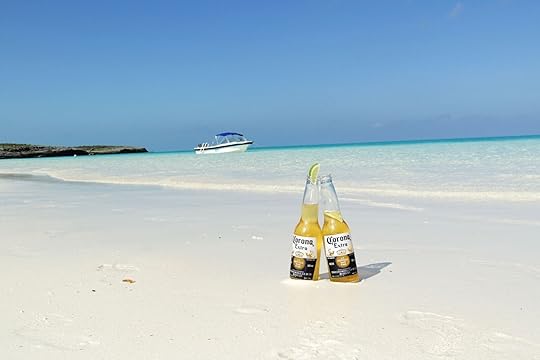
Back in 2021, you had to be on an exclusive list to “la vida más fina” — live the fine life.
But as of March 18, now anyone can make a reservation to party at an island owned and themed after Corona beer, owned by Anheuser-Busch. The beer brand just opened its private island off the coast of Colombia, about 12 miles southwest of Cartagena. It’s accessible only by boat, and is billed as “a place where time stands still and all that surrounds you is crystal clear waters, white sand, and nature at its finest.”
The island has actually been open since 2021, but it was on an invite-only basis. But Clarissa Pantoja, global vice president of Corona, recently told The Drinks Business that the company had seen how successful the island was and was ready to scale it up and welcome members of the public. “Given its success, Corona now welcomes eco-conscious travellers from around the world to experience the island and truly disconnect to reconnect with nature,” she said.
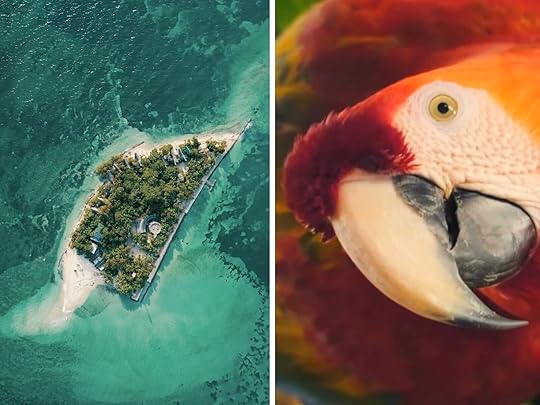
Photo: Corona Island Instagram
The point of Corona Island appears to be multifaceted, serving both as a brand extension and a unique experience for visitors. The brand’s marketing aligns the light, Mexican-style lager with beach vacations and warm weather, so it’s not a surprise to see it associated with a tropical island paradise. The private island is aimed at both day trippers and overnight guests, as both overnight and day passes include round-trip transportation from the mainland. The architecture, style, and layout appear to be reminiscent of a Tulum hotel, with eco-friendly materials, natural coloring, and lots of indoor-outdoor living.
Day trippers can book a pass to Corona Island starting at 672,269 Colombian Pesos (about $165), plus a 19 percent tax. Pickup is at 8:30 AM and return at 3 PM, giving buyers a morning and early afternoon on the island. Also included are a three-course lunch, access to sunbeds and loungers, and “Corona beer” (but no word on how many).
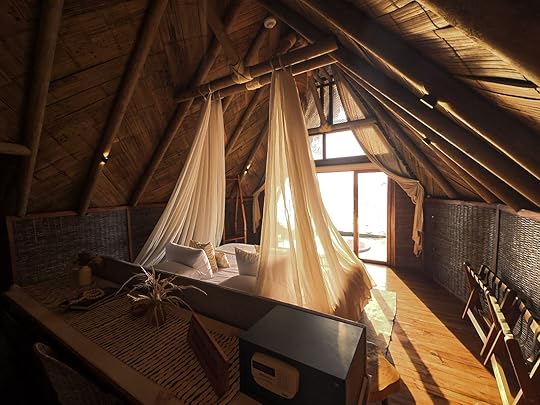
A King Bungalow on “Corona Island.” Photo: Corona Island
Travelers who want to stay for more than one night can book either a “King Bungalow,” with a private beachfront hot tub and minibar stocked with Corona, or a “Twin Bed Bungalow,” with similar features but a layout for travelers who don’t want to share a bed. Both rooms start around $614 per night plus tax and include transportation, your room, and all meals. For an extra undisclosed fee, guests can add on experiences like “mangrove reforestation,” snorkeling tours, spa services, or paddleboard and kayak rentals.
Both day visits and overnight stays are limited to adults only. Booking is currently available now, though there’s no word if the island is a permanent experience, or something that will be available for just a limited time. Interestingly, and perhaps tying in with the travel ethos of younger visitors, the island has a handful of sustainability initiatives. It was the world’s first “three-star Blue Seal”-awarded island from Oceanic Global, received for “eliminating single-use plastics and incorporating comprehensive sustainability measures throughout their operations and guest experience.”

A wide beach on “Corona Island.” Photo: Corona Island
The island is also run entirely with solar energy, relies on local and native drought-tolerant plants, and was built with local materials and techniques. Before it became “Corona Island,” it was used as a popular destination for boat rentals in the area, offering an undeveloped island and three large stretches of sandy beach. it’s part of the country’s Rosario Islands, and is still technically called “Isla Arena,” though it does come up on Google Maps as “Corona Island,” as well. 
United Airlines Just Added Bartender-Approved, In-Flight Cocktails to Its Domestic Routes

In-flight cocktails are often lackluster, and that’s being generous. But United Airlines is changing that on certain routes. Crafthouse Cocktails, the award-winning ready-to-drink (RTD) brand co-founded by renowned mixologist Charles Joly, is now available on select United Airlines domestic flights — bringing bar-quality libations to 30,000 feet.
The Chicago-based Crafthouse Cocktails is known for its commitment to natural ingredients and cocktail recipes curated by James Beard Award nominee Charles Joly. “We’re thrilled to partner with United to elevate the inflight experience by offering passengers the balance and flavors they’d expect from their favorite cocktail bar,” Joly said in a press release.

Photo: Crafthouse Cocktails
United is now serving four Crafthouse favorites, including the espresso martini, moonlighter, mai tai, and pineapple daiquiri. The cocktails are complimentary in United Business and United First, and available in United Economy for $12 on domestic flights over 300 miles and flights between the mainland United States and Hawaii.
Beyond the cabin, Crafthouse’s rise reflects broader shifts in the RTD market. According to Fortune Business Insights, global RTD beverage sales are projected to reach $1.2 trillion by 2032, driven by consumer demand for convenience and quality. Crafthouse’s approach — eschewing citric acid in favor of real citrus and partnering with high-end spirit producers like Plantation Rum and La Cofradia Tequila — has carved out a niche among discerning drinkers.
As the RTD cocktail space continues its meteoric rise, Crafthouse is proving that convenience and craftsmanship can coexist. And thanks to its new partnership with United Airlines, travelers can now savor a sophisticated cocktail experience midair—no bar tab, no turbulence. 
The Most Convenient Airbnbs in Each of Dublin’s Top Neighborhoods for Visitors
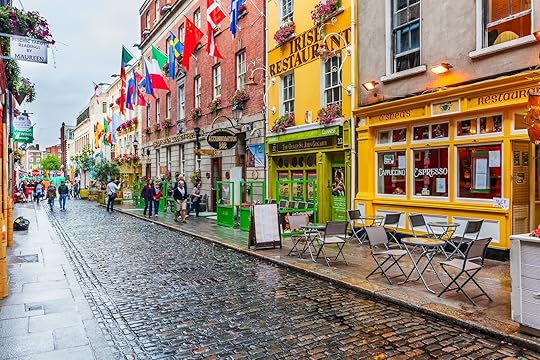
Teeming with historical attractions, gorgeous green spaces, and epic pubs, Dublin is a charismatic city you’ll not forget in a hurry – subject to how many pints of Guinness you knock back. The spirited Irish capital draws backpackers, couples, and families in equal measure. Whether you’re hankering after a weekender or planning a pitstop on a wider Emerald Isle adventure, you need to know where to stay in Dublin. Check out our guide to Airbnb Dublin, Ireland, scene in and around the city center.
These Airbnbs in Ireland Showcase the Best of the Emerald Isle Rent The Holiday Pub in Cork or Tipperary for the ultimate Irish getawayThe best Airbnbs in Belfast, from the Titanic Quarter to Shankill Road10 Airbnbs Make You Feel Like You’re Living in Game of ThronesStay like royalty at these Airbnb Ireland castle rentals
We hope you love the Airbnb Dublin vacation rentals we recommend! Just so you know, Matador may collect a small commission from the links on this page if you decide to book a stay. Listed prices are accurate as of the time of publication.
Coolest Dublin Airbnbs – St. Stephen’s Green and PortobelloDublin Airbnb rentals in Temple BarUnforgettable Dublin Docklands AirbnbsRelaxing Airbnbs in Monkstown, Dublin BayBest Airbnbs in Dublin, MalahideCoolest Dublin Airbnbs – St. Stephen’s Green and PortobelloThe Tailor’s Room – boutique pad in Central Dublin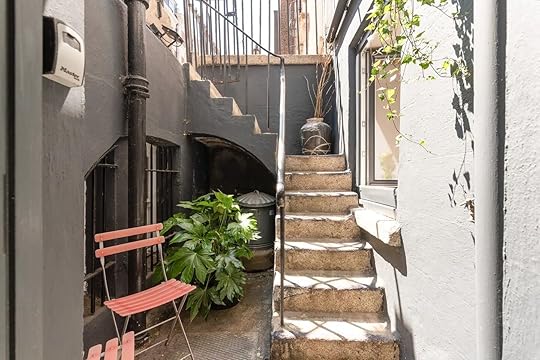 Photo: Airbnb
Photo: Airbnb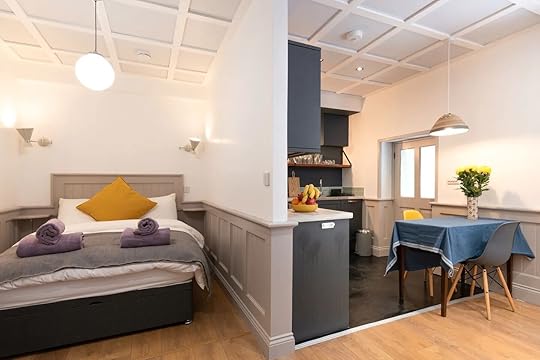 Photo: Airbnb
Photo: Airbnb Photo: Airbnb
Photo: Airbnb Photo: Airbnb
Photo: AirbnbSee more photos
This meticulously renovated basement apartment Airbnb in Dublin’s city center is right in the core of the historic quarter. The bed is partitioned from the main living zone where you can fling open the window and let fresh air and natural light flood the space. When the sun shines, make yourself at home on the hidden patio. A short stroll from Dublin Castle and St Patrick’s Cathedral, St. Stephen’s Green offers a quieter environment in comparison to neighboring Temple Bar.
Two guests, one bedroom (studio)
Price: $205 per night
 Photo: Airbnb
Photo: Airbnb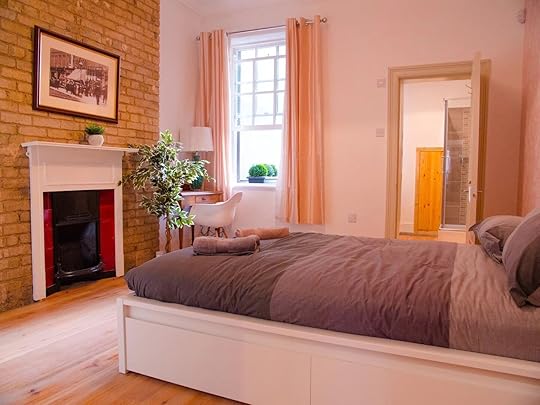 Photo: Airbnb
Photo: Airbnb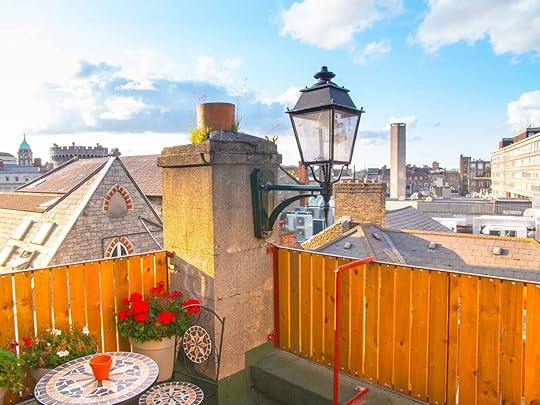 Photo: Airbnb
Photo: Airbnb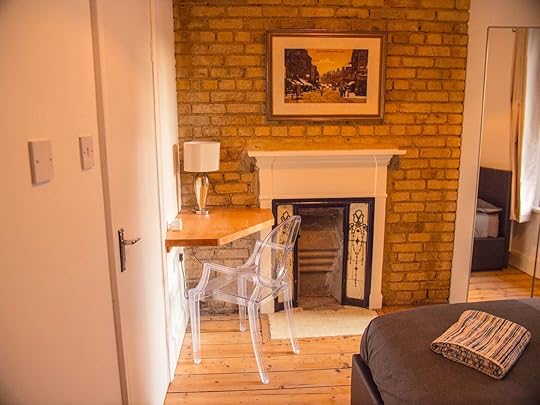 Photo: Airbnb
Photo: AirbnbSee more photos
Kick back in this voguish Dublin Airbnb apartment steps away from Grafton Street, Trinity College, and St. Stephen’s Green. Each of the four double bedrooms comes with its own fireplace and bathroom. Sure to delight those who need solitude in the morning, one even has its own kitchenette. Climb up onto the roof terrace with a mug of joe and plot out your day in Dublin with a picturesque backdrop.
Nine guests, four bedrooms
Price: $1,245 per night
 Photo: Airbnb
Photo: Airbnb Photo: Airbnb
Photo: Airbnb Photo: Airbnb
Photo: Airbnb Photo: Airbnb
Photo: AirbnbSee more photos
This Airbnb in the Dublin city center is ideal for large groups, occupying a former cobbler’s workshop. Although carefully refurbished to cater to modern travelers, the lounge decor remains faithful to the heritage of the building with exposed stonework and industrial-chic touches. At full capacity, this family-friendly vacation property on the corner of the green can accommodate fifteen guests. The walled backyard and nursery with a crib make it a top contender for those with younger kids.
Fifteen guests, six bedrooms
Price: $1,995 per night
 Photo: Airbnb
Photo: Airbnb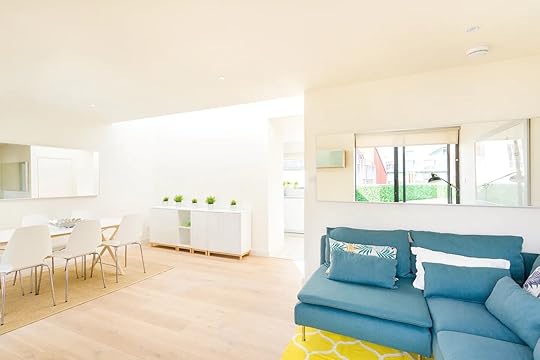 Photo: Airbnb
Photo: Airbnb Photo: Airbnb
Photo: Airbnb Photo: Airbnb
Photo: AirbnbSee more photos
Slap-bang in the middle of the nightlife hub, this penthouse Airbnb in the heart of the Dublin city center is a perfect pick for those looking to sample the best of Irish nightlife. The squeaky clean minimalist space consists of two double bedrooms each with its own bathroom, a full kitchen, and an airy lounge that opens out onto a spacious patio.
Four guests, two bedrooms
Price: $285 per night
 Photo: Airbnb
Photo: Airbnb Photo: Airbnb
Photo: Airbnb Photo: Airbnb
Photo: AirbnbSee more photos
Kitted out with funky pieces of art, scarlet-hued settees, and a well-stocked bookshop, this Temple Bar Dublin Airbnb is an oasis from the bustle down below. The compact kitchen contains all you need to rustle together a meal before a night in the local pubs while views of the River Liffey add charm.
Two guests, one bedroom
Price: $250 per night
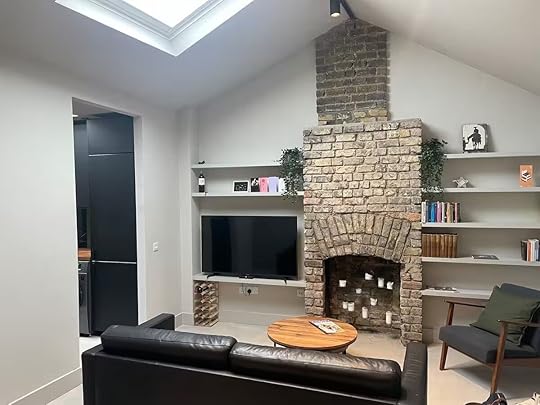 Photo: Airbnb
Photo: Airbnb Photo: Airbnb
Photo: Airbnb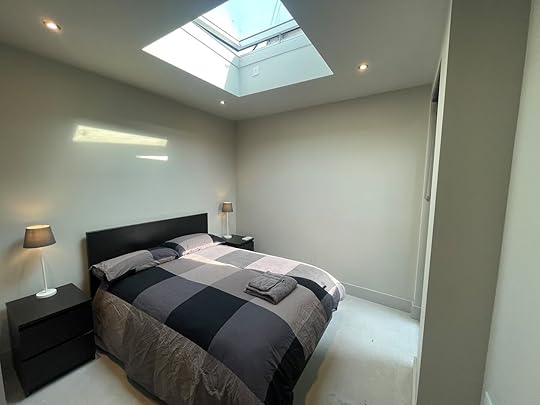 Photo: Airbnb
Photo: AirbnbSee more photos
The interior of this spot exudes warmth, as any good Irish residence must, with a cozy interior, modern amenities, and walkability that creates an inviting atmosphere no matter what you’re doing in Temple Bar (we have a guess). The area is iconic of Dublin’s rich cultural tapestry, and its pubs. Renowned landmarks such as Trinity College and St. Stephen’s Green are within easy walking distance, while an array of traditional pubs, gourmet restaurants, and boutique shops await.
Two guests, one bedroom
Price: $202 per night
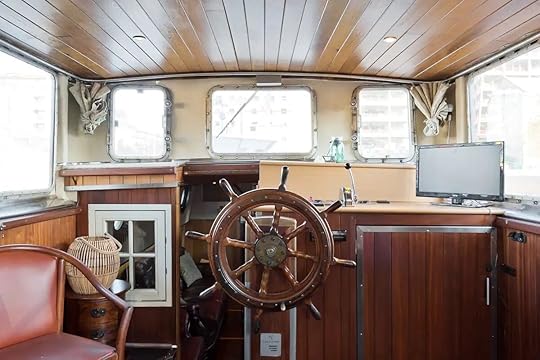 Photo: Airbnb
Photo: Airbnb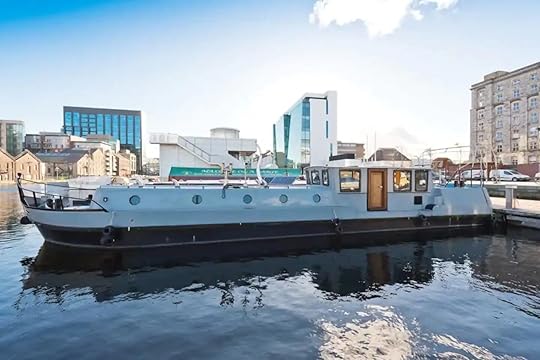 Photo: Airbnb
Photo: Airbnb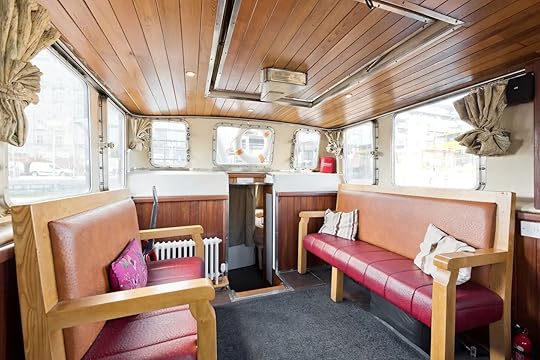 Photo: Airbnb
Photo: Airbnb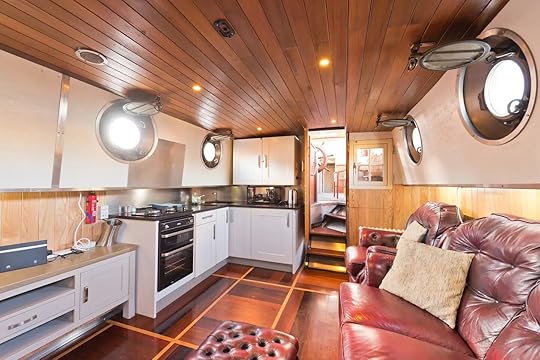 Photo: Airbnb
Photo: AirbnbSee more photos
All aboard the best Dublin Airbnb houseboat! Moored in the Charlotte Key Docks complex at Grand Canal, the vacation home is within walking distance of the city center. Each of the three cabins contains a double bed. The galley is rigged with a fully-functional kitchen, plump leather couches, a wood burner, and the captain’s helm – awesome for a selfie. On a sunny afternoon, you can sit out on the deck and soak up the nautical atmosphere.
Four guests, three bedrooms
Price: $420 per night
 Photo: Airbnb
Photo: Airbnb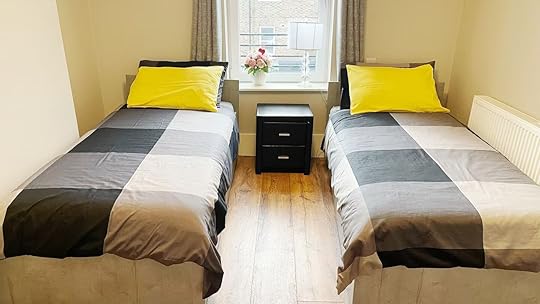 Photo: Airbnb
Photo: Airbnb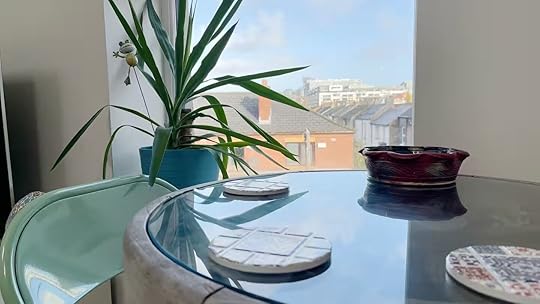 Photo: Airbnb
Photo: AirbnbSee more photos
This stylish high-ceiling home offers guests an exquisite blend of historic charm and modern luxury. The spacious interiors are bathed in natural light, highlighting contemporary furnishings and tasteful décor that create an inviting atmosphere. With a fully equipped kitchen and comfortable sleeping arrangements, the place is ideal for cooking and raising a pint at happy hour. Renowned landmarks such as Trinity College and St. Stephen’s Green are within easy walking distance, while an array of pubs, restaurants, and shops await — and there’s room for a decent group, as up to six can stay in the pad.
Six guests, two bedrooms
Price: $186 per night
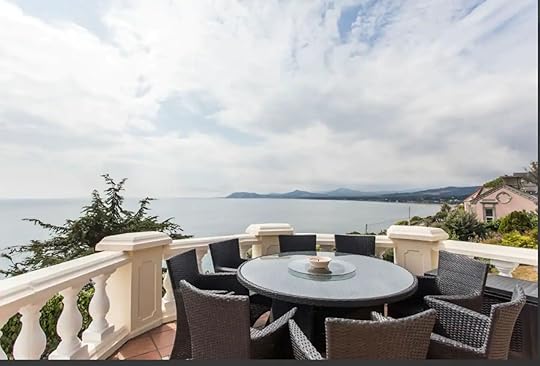 Photo: Airbnb
Photo: Airbnb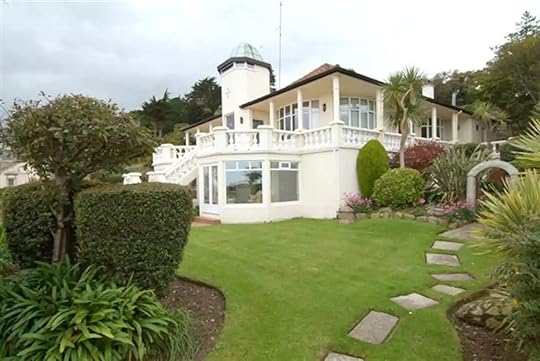 Photo: Airbnb
Photo: Airbnb Photo: Airbnb
Photo: Airbnb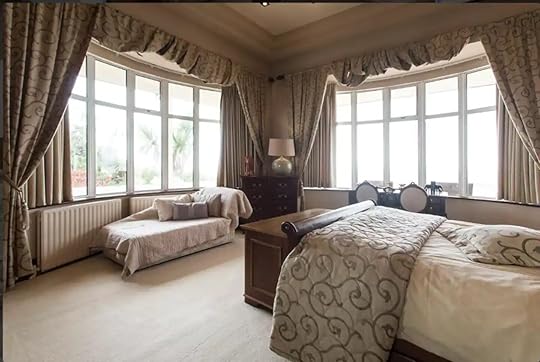 Photo: Airbnb
Photo: AirbnbSee more photos
Flee the city center for a night and savor R&R with a view of the Irish Sea from this Mediterranean-style Airbnb in Monkstown, Dublin. A wide terrace on the upper story grants dreamy panoramas across the water from this village-like suburb. Interiors are dressed with period furnishings and upholstery but topped off with state-of-the-art appliances. The sauna and games room are two key highlights of this family-friendly home. The center of Dublin is a 25-minute drive away or 30 minutes via the DART commuter line.
Thirteen guests, six bedrooms
Price: $1,525 per night
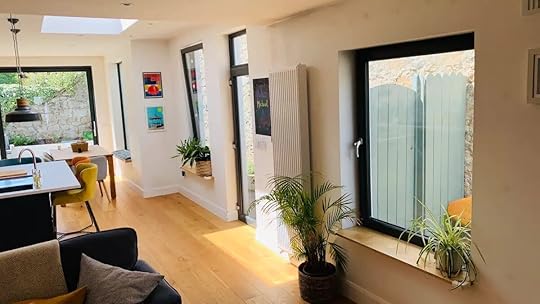 Photo: Airbnb
Photo: Airbnb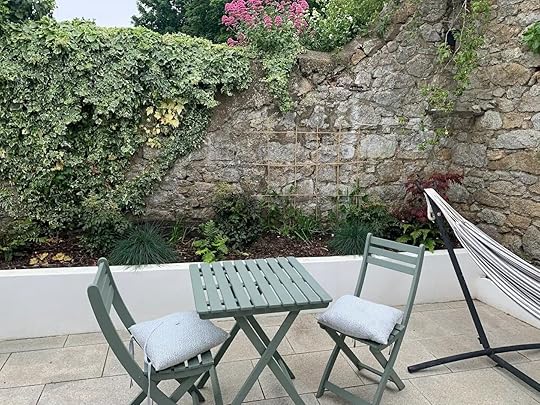 Photo: Airbnb
Photo: Airbnb Photo: Airbnb
Photo: AirbnbSee more photos
Nestled in between Monkstown and Dún Laoghaire, this two-story end terrace is the seaside abode of a local family. This is reflected in the style of the rental – you’ll find all your creature comforts and appreciate the homely ambiance. French sliders reveal a secluded back patio with seating and a hammock. All in all, this is the perfect family-friendly Airbnb in Monkstown.
Five guests, two bedrooms
Price: $355 per night
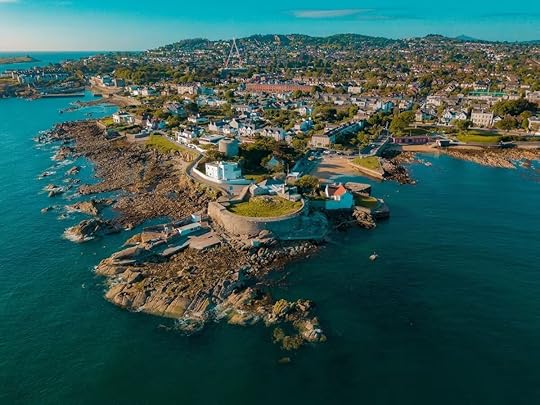 Photo: Airbnb
Photo: Airbnb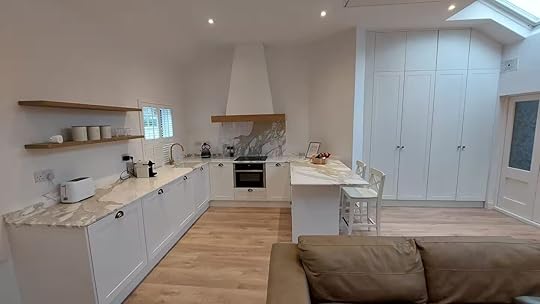 Photo: Airbnb
Photo: Airbnb Photo: Airbnb
Photo: AirbnbSee more photos
This remodeled cottage offers a harmonious blend of traditional Irish charm and modern luxury — and it’s right by the bay, so the views are epic. The interior boasts contemporary furnishings that complement the cottage’s classic architecture. The kitchen is chef’s quality, the place is spacious by European standards, and its walkable to the surrounding pubs and neighborhood. Four a small group or single family, it’s an ideal spot to post up.
Stepping outside, visitors are greeted by the picturesque streets of Dalkey, renowned for their historic allure and vibrant local culture. A short stroll leads to an array of quaint shops, traditional pubs, and gourmet restaurants, offering an authentic taste of Irish hospitality. For those keen on exploration, the nearby coastline provides scenic walks with breathtaking sea views, making this cottage an ideal base for both relaxation and adventure.
Four guests, two bedrooms
Price: $293 per night
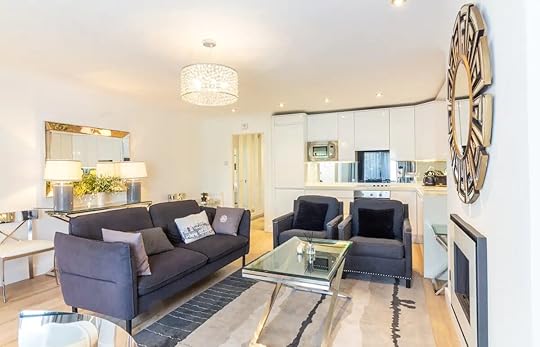 Photo: Airbnb
Photo: Airbnb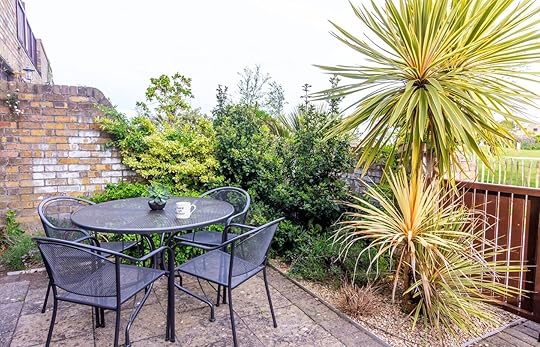 Photo: Airbnb
Photo: Airbnb Photo: Airbnb
Photo: Airbnb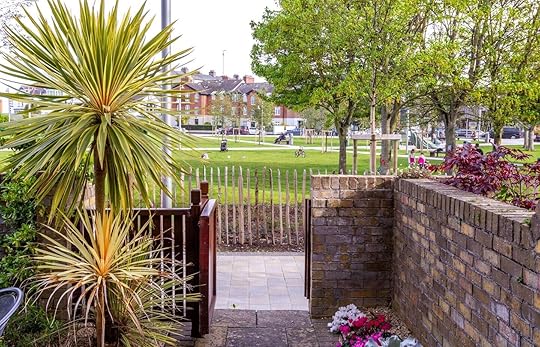 Photo: Airbnb
Photo: AirbnbSee more photos
Located a 20-minute drive (30 via DART), Malahide is a charming seaside resort with pretty beaches and a castle. It’s suitable for guests who want to fuse city attractions by day with sleepier – yet devastatingly scenic – digs. This modern but homey Airbnb family home comes with two bedrooms and a terrace surrounded by greenery. Situated conveniently in Malahide Marina, it’s a top choice for sunset lovers. [mn-post-enders]
Three guests, two bedrooms
Price: $240 per night
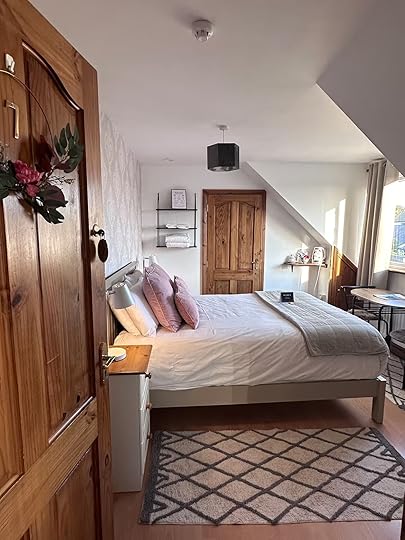 Photo: Airbnb
Photo: Airbnb Photo: Airbnb
Photo: Airbnb Photo: Airbnb
Photo: AirbnbSee more photos
The picturesque coastal village of Malahide is a nice alternative to busy Dublin that still provides easy access to the city, and this charming guest house offers travelers a serene retreat just a stone’s throw from Dublin’s vibrant city center. The double ensuite room provides a cozy and comfortable space, perfect for couples or solo adventurers seeking tranquility. Guests can enjoy modern amenities, ensuring a restful stay amidst the quaint Irish surroundings.
Beyond the comfort of your room, Malahide boasts a rich tapestry of attractions. Stroll through the lush grounds of Malahide Castle, indulge in local cuisine at nearby eateries, or take a leisurely walk along the marina. With easy access to public transportation, Dublin’s cultural landmarks are within effortless reach, making this guest house an ideal base for both relaxation and exploration. 
Two guests, one bedroom
Price: $122 per night
These 11 Airbnbs Place You in the Heart of the World’s Most Stunning Wildlife Destinations
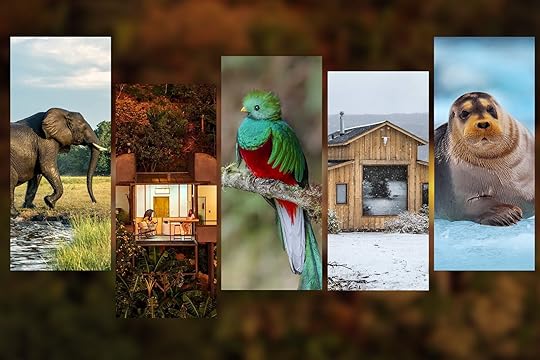
For a wildlife photographer, scoring the perfect image means immersion within the habitat. If you want to witness and document some of the planet’s most impressive wildlife spectacles, these Airbnbs will set you up for success. From the elephant herds of Botswana’s Chobe National Park, where a riverfront villa places you at the heart of the action, to the cloud forests of Monteverde, where a treehouse cabin provides a vantage point for observing endemic birds and monkeys, these rentals offer you front-row seats and some of the best conditions for wildlife viewing in the world.
We hope you love the Airbnbs we recommend! Just so you know, Matador may collect a small commission from the links on this page if you decide to book a stay. Listed prices are accurate as of the time of publication.
To capture the elusive resplendent quetzal in its natural habitat, Monteverde’s cloud forests, Costa Rica Photo: Airbnb
Photo: Airbnb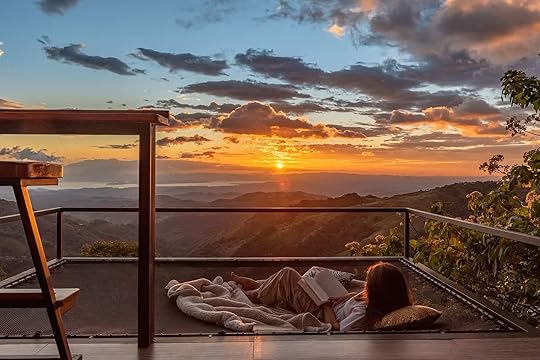 Photo: Airbnb
Photo: Airbnb Photo: crbellette, Bob Hilscher/Shutterstock
Photo: crbellette, Bob Hilscher/Shutterstock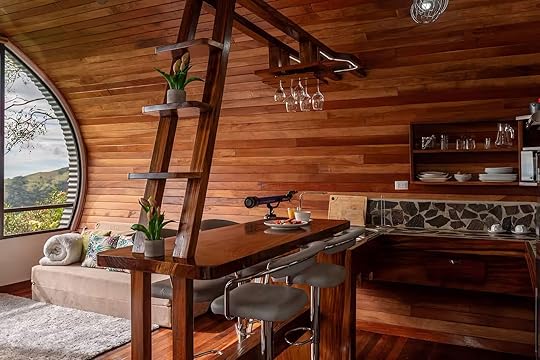 Photo: Airbnb
Photo: Airbnb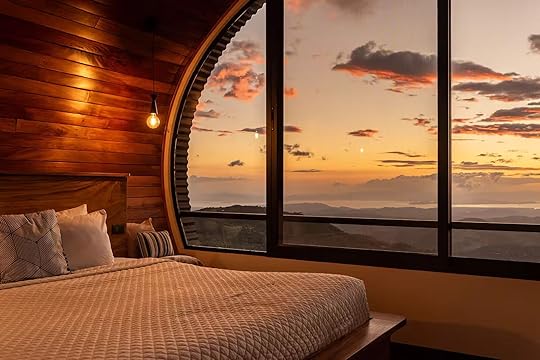 Photo: AirbnbSee more photos
Photo: AirbnbSee more photosEarly morning or late afternoon are the optimal times for better light and animal activity in Monteverde. Giving yourself the gift of flexibility and time to enjoy photography here will significantly improve your experience, your chances of seeing more wildlife, and the end product. That’s why having a base in the forest is a must. This area of Costa Rica is a haven for wildlife due to the cloud forest ecosystem. Expect to see the colorful, resplendent quetzals, hummingbirds, howler monkeys, two-toed and three-toed sloths, red-eyed tree frogs, snakes, and tarantulas. One of the dreamest Airbnbs in the forest is this cabin in the trees. It’s within a private estate, so there’s a nice blend of luxury and adventure. The cozy space offers breathtaking mountain views and unforgettable sunsets from the deck and Jacuzzi.
Three guests, one bedrooms
Price: $439 per night
 Photo: Airbnb
Photo: Airbnb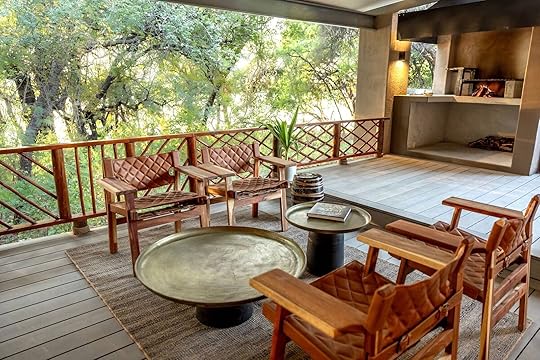 Photo: Airbnb
Photo: Airbnb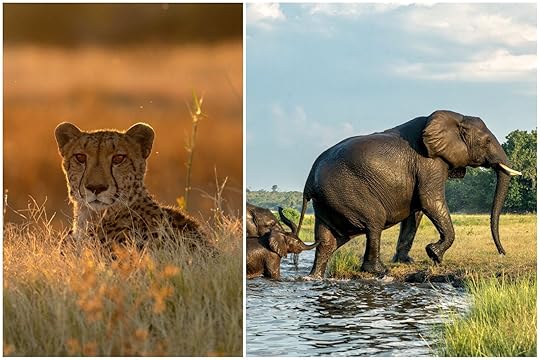 Photo: 2630ben, Henk Bogaard/Shutterstock
Photo: 2630ben, Henk Bogaard/Shutterstock Photo: Airbnb
Photo: Airbnb Photo: AirbnbSee more photos
Photo: AirbnbSee more photosAt the end of Botswana’s dry season (May to October), Chode National Park is one of the best places in the world to see herds of elephants. Over 120,000 elephants call this area of Botswana home, and the river that runs through the northeastern border of the park delivers some of the best safari boat cruises in the world. This four-bedroom private villa has an unbeatable location right on the water and three minutes by boat from the park entrance. It might be considered a bit pricey, but if you have a group, it’s considerably cheaper than staying at a nearby safari lodge. The property is fully staffed and luxurious. The large open deck with a private pool looks over the river, where hippos often relax under the trees; each bedroom has an ensuite, and there’s a library, gym, private jetty, and an outdoor dining area.
Eight guests, four bedrooms
Price: $1,173 per night
 Photo: Airbnb
Photo: Airbnb Photo: Airbnb
Photo: Airbnb Photo: Maridav/Shuttestock
Photo: Maridav/Shuttestock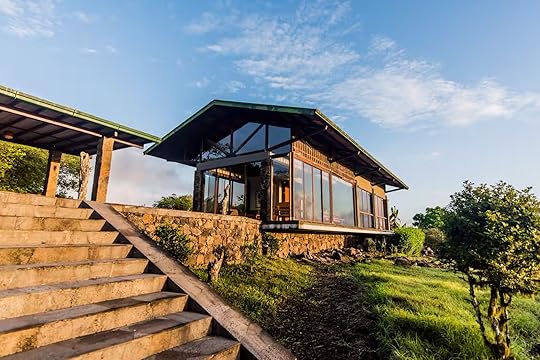 Photo: Airbnb
Photo: Airbnb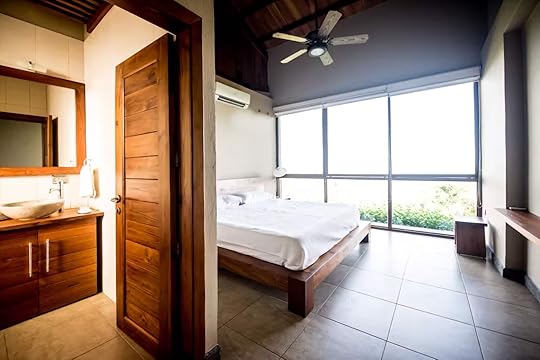 Photo: AirbnbSee more photos
Photo: AirbnbSee more photosThe Galápagos Islands need no introduction. The archipelago is on the list of any wildlife enthusiast, and those lucky enough to visit return with stories that bolster its legendary status as one of Earth’s most scientifically important and biologically outstanding areas. The journey includes border crossings and multiple flights, but it wouldn’t be such a natural paradise if it were close to civilization. Getting there is expensive, but there are a handful of afforable Airbnbs that can help keep your budget in check. This villa sleeps five and is located on the slopes of an inactive volcano on Santa Cruz Island, almost 400 meters above sea level. The Scandinavian-style property is surrounded by endemic Scalesia trees and fruit (oranges, lemon, and tangerine) trees — which guests can harvest during their stay. And you won’t need to go far to see a Galápagos giant tortoise as they roam the property’s grounds.
Five guests, two bedrooms
Price: $585 per night
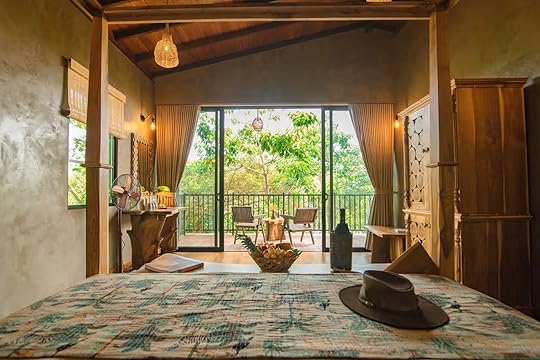 Photo: Airbnb
Photo: Airbnb Photo: Airbnb
Photo: Airbnb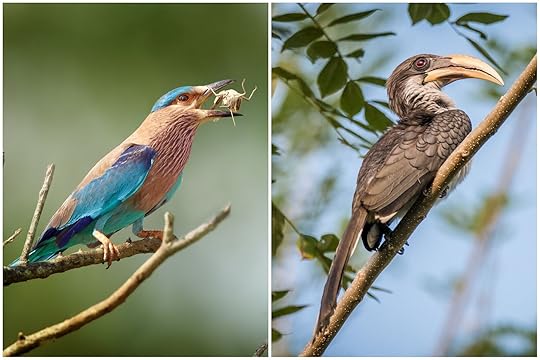 Photo: Martin Mecnarowski, Lubos Houska/Shutterstock
Photo: Martin Mecnarowski, Lubos Houska/Shutterstock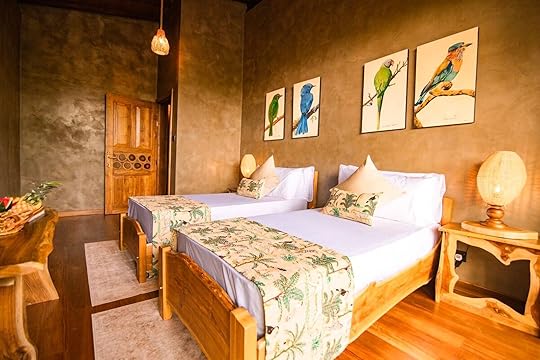 Photo: Airbnb
Photo: Airbnb Photo: AirbnbSee more photos
Photo: AirbnbSee more photosThe southern littoral of Sri Lanka has some exceptional protected areas for birdlife. The Yala, Bundala, Lunugamwehera, and Udawalawe National Parks offer diverse habitats, from arid scrublands to wetlands and seasonal waterholes, perfect for various birdlife. The region is also within the Indian subcontinent’s migratory flyway, with seasonal influxes of waterbirds and raptors. You can find endemic species, such as the Sri Lanka Junglefowl, the Sri Lanka Grey Hornbill, and the Sri Lanka Woodshrike, alongside many smaller passerines, including warblers, flycatchers, and babblers. This luxury lakefront safari house is within a bird sanctuary near the parks and Weerawila Lake. Although it’s a private residence, it is part of a hotel, so guests can use those facilities and enjoy a complimentary breakfast before heading out for a shoot.
Five guests, two bedrooms
Price: $440 per night
 Photo: Airbnb
Photo: Airbnb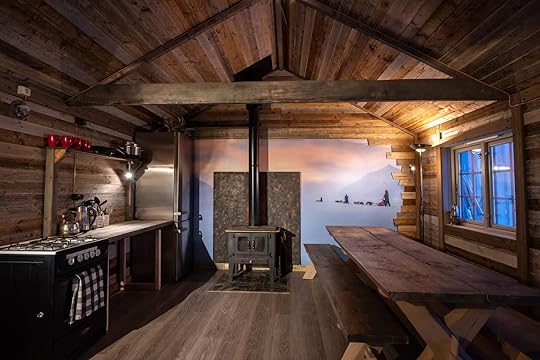 Photo: Airbnb
Photo: Airbnb Photo: Ondrej Prosicky, Incredible Arctic/Shutterstock
Photo: Ondrej Prosicky, Incredible Arctic/Shutterstock Photo: Airbnb
Photo: Airbnb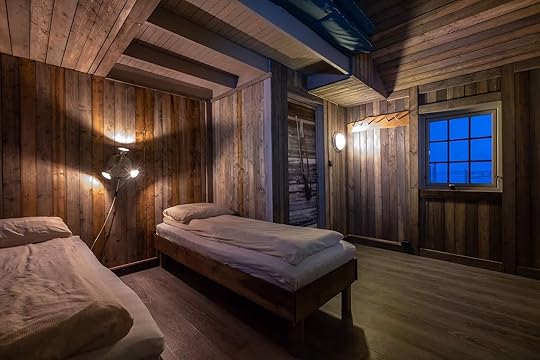 Photo: AirbnbSee more photos
Photo: AirbnbSee more photosThis region’s stark, glacial landscapes and extreme climatic conditions create a dramatic backdrop for capturing images of Arctic wildlife. Depending on when you’d like to visit, the midnight sun during summer and the polar night during winter offer very different but equally impressive lighting conditions. The polar bear is the primary subject for many, but you’ll also have the chance to see the endemic Svalbard reindeer, walruses, and various species of seals, such as the bearded and ringed seals. Accommodations in the area are in limited supply. You need to plan a trip to Svalbard in advance and do your research (perhaps even including getting a local guide). This Airbnb cabin is near Longyearbyen on Spitsbergen (the largest island in the archipelago.) It’s the main settlement area, so it’s accessible and makes an ideal base for exploring the region. It sleeps up to seven people, and one of the bedrooms benefits from a glass ceiling that allows you to watch the northern lights dancing across the night sky from bed.
Seven guests, three bedrooms
Price: $251 per night
 Photo: Airbnb
Photo: Airbnb Photo: Airbnb
Photo: Airbnb Photo: grafxart/Shuttestock
Photo: grafxart/Shuttestock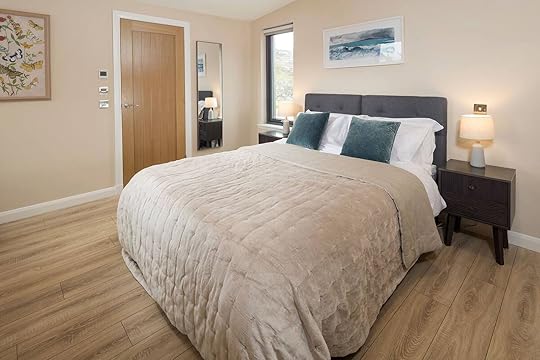 Photo: Airbnb
Photo: Airbnb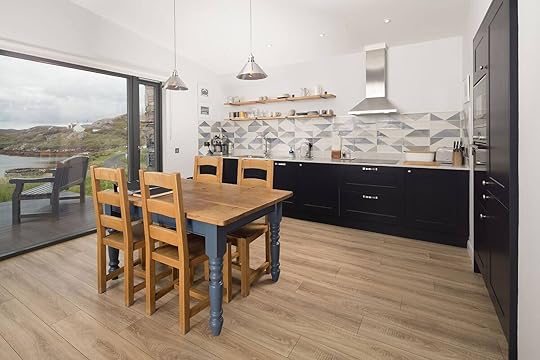 Photo: AirbnbSee more photos
Photo: AirbnbSee more photosSt. Kilda, a remote archipelago 40 miles west of the Outer Hebrides in Scotland, is home to seabird colonies, namely the largest puffinry of Atlantic puffins in the UK and Northern gannets, and free-roaming Soay sheep. Also known as Hiort, in Scottish Gaelic, the landscape of rugged terrains, towering sea cliffs, and exposed moorland create a dramatic backdrop for photographing these beautiful species. There’s camping on the main island but no formal accommodations. Because of this, I choose a nearby Guest Favorite one-bedroom cottage on the Isle of Harris. Plenty of boat trips leave Harris for St. Kilda, but because seeing the circus of puffins is high on the list of many visitors and locals in the country, you should book boats as far in advance as possible.
Two guests, one bedroom
Price: $237 per night
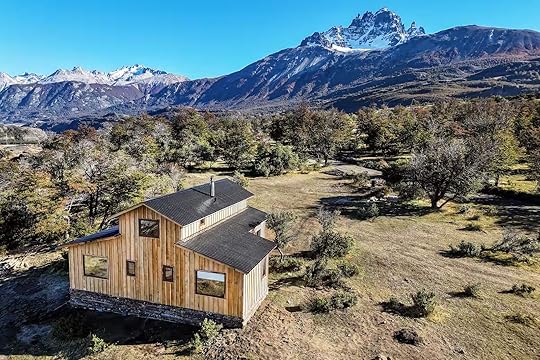 Photo: Airbnb
Photo: Airbnb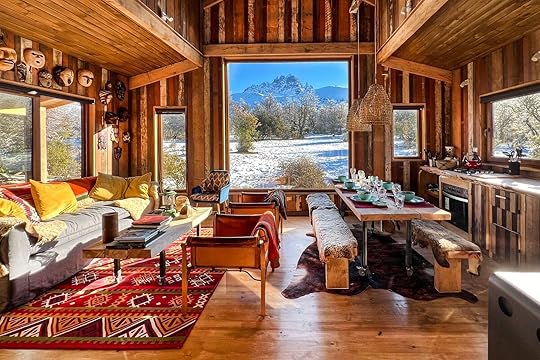 Photo: Airbnb
Photo: Airbnb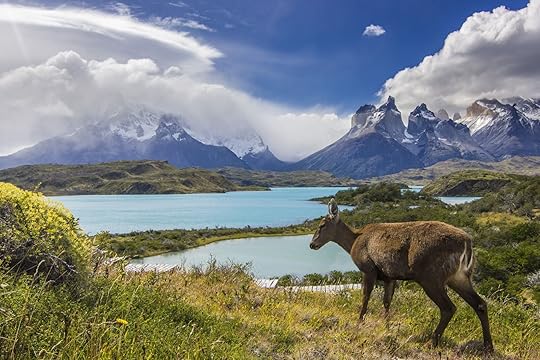 Photo: Olena Viktorova/Shuttestock
Photo: Olena Viktorova/Shuttestock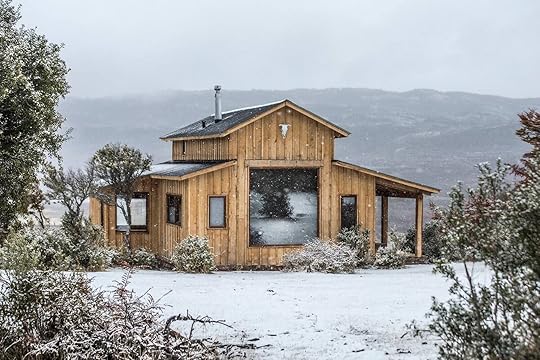 Photo: Airbnb
Photo: Airbnb Photo: AirbnbSee more photos
Photo: AirbnbSee more photosThe Río Ibáñez region of Aysén, and Patagonia as a whole, are home to diverse landscapes: Andean foothills, steppe grasslands, and glacial watersheds. This combination creates habitats for many species, and the region’s remoteness, coupled with its relatively low human population density, allows for observation of wildlife in a largely undisturbed state. The main draw is the Patagonian mammals. If you’re lucky (and have a deep understanding of animal behavior), you might spot a puma. You’ll likely see guanaco, a wild relative of the llama, and an Andean deer, or huemul. Huemuls are shy, so again, you’ll need to do fieldwork and perhaps get a local guide to see the largest native deer in Chile. This three-bedroom cabin is one of the top one percent listings on Airbnb. It overlooks Patagonia National Park and is decorated with traditional Chilean textiles and artwork.
Six guests, three bedrooms
Price: $287 per night
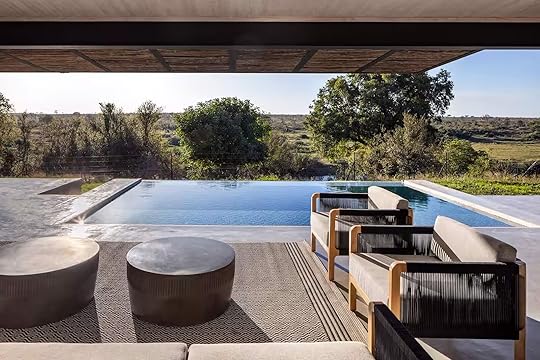 Photo: Airbnb
Photo: Airbnb Photo: Airbnb
Photo: Airbnb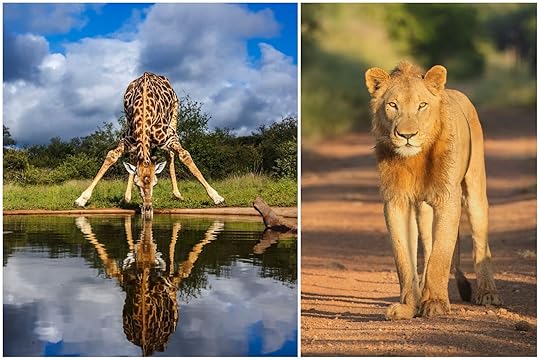 Photo: PACO COMO, Miroslav Srb/Shutterstock
Photo: PACO COMO, Miroslav Srb/Shutterstock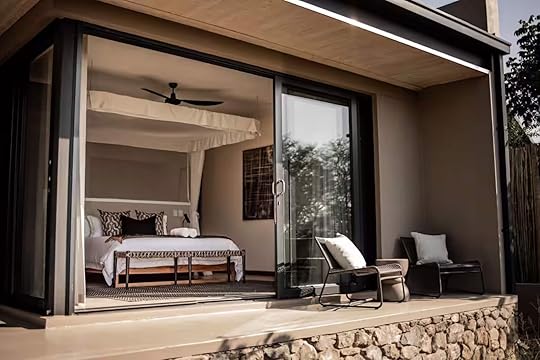 Photo: Airbnb
Photo: Airbnb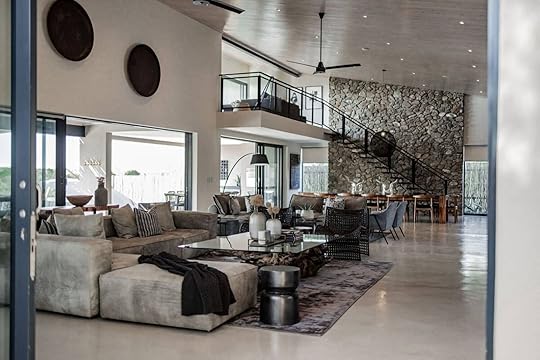 Photo: AirbnbSee more photos
Photo: AirbnbSee more photosThe dry winter months, from May to September, offer optimal conditions for photography in Kruger National Park. The sparse vegetation and concentrated water sources increase the likelihood of encountering the Big Five — lion, leopard, rhinoceros, elephant, and buffalo. There’s a surprising number of Airbnbs and lodges in or near the park. If my suggestion of where to stay is too expensive, check out Matador’s largest selection of other vacation rentals. With views of the Crocodile River and renowned Kruger National Park, this Airbnb is a modern architectural masterpiece, blending indoor-outdoor living seamlessly. Ideal for multi-generational families or small groups of close friends, the house sleeps 10 in its luxury five bedrooms. The waterfront property has WiFi, free parking, a swimming pool, and an expansive deck with a fire pit and outdoor dining facilities.
10 guests, five bedrooms
Price: $1,247 per night
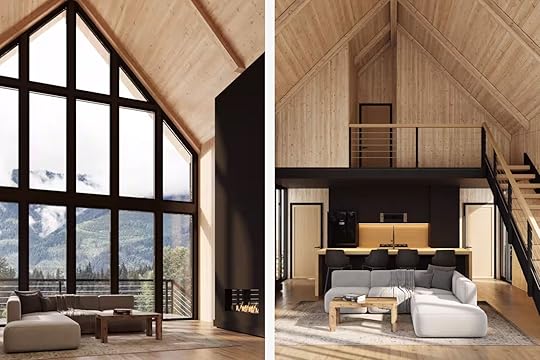 Photo: Airbnb
Photo: Airbnb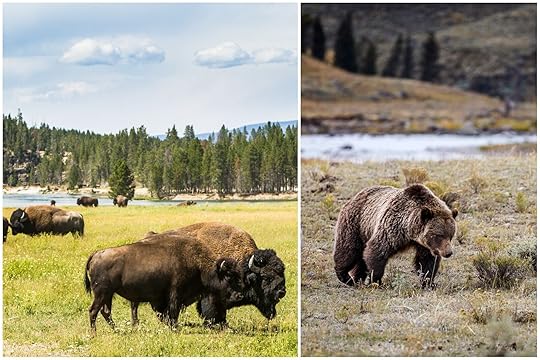 Photo: Laurens Hoddenbagh, Ben Wickham/Shutterstock
Photo: Laurens Hoddenbagh, Ben Wickham/Shutterstock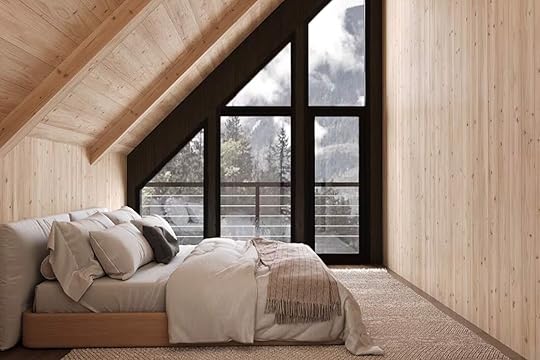 Photo: Airbnb
Photo: Airbnb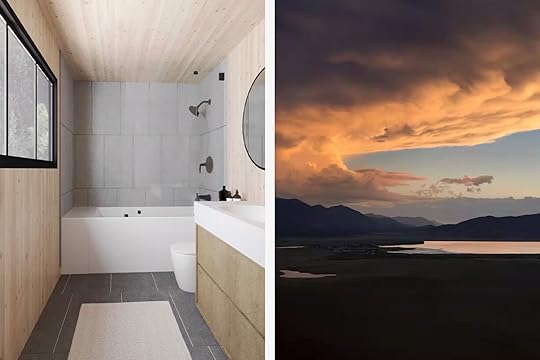 Photo: AirbnbSee more photos
Photo: AirbnbSee more photosYou don’t have to go halfway around the world to flex your wildlife photography muscles; Yellowstone is one of the many parks in the US with exceptional wildlife viewing opportunities. Yellowstone’s megafauna are a primary draw for photographers. Elk, bison, and pronghorn are abundant. Wolves and grizzly bears, though more elusive, are present, requiring significant time and knowledge of their habits to photograph, and smaller mammals, such as coyotes, badgers, and marmots, also contribute to the park’s biodiversity. You’re spoilt for choice for Airbnbs near the gateways to the park. This family cabin not only has a jaw-dropping view and hot tub, it’s just minutes from West Yellowstone. The two-bedroom has a modern Scandinavian style, floor-to-ceiling windows, and a stylish neutral color pallet.
Eight guests, three bedrooms
Price: $541 per night
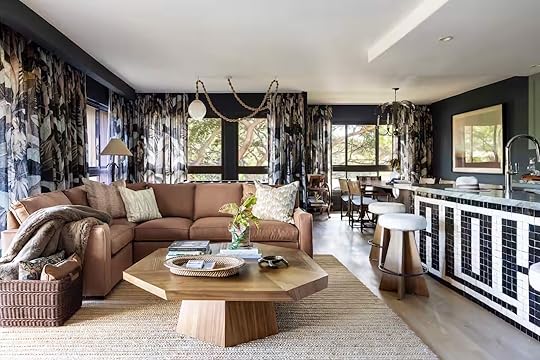 Photo: Airbnb
Photo: Airbnb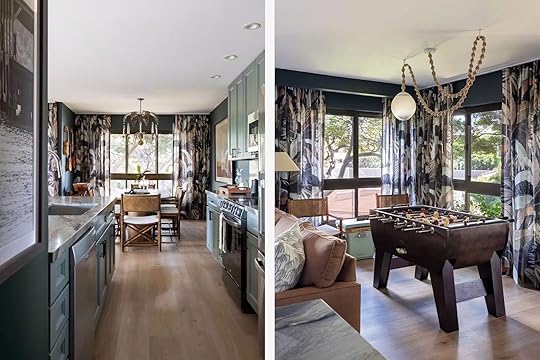 Photo: Airbnb
Photo: Airbnb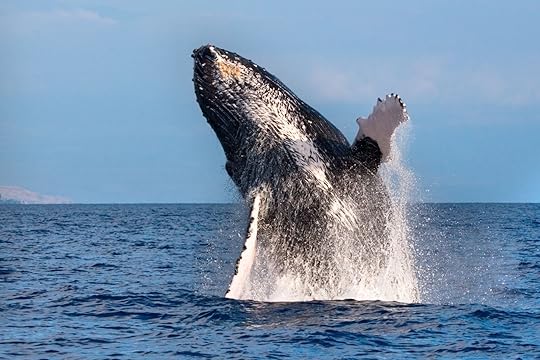 Photo: idreamphoto/Shuttestock
Photo: idreamphoto/Shuttestock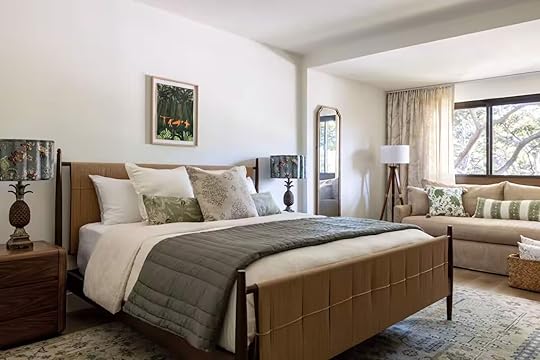 Photo: Airbnb
Photo: Airbnb Photo: AirbnbSee more photos
Photo: AirbnbSee more photosMaui’s isolation means a high degree of endemism, and its topography, ranging from coastal reefs to high-altitude forests, creates many habitats for land and water species. In a nutshell, it’s a playground for any wildlife enthusiast. During winter, the waters surrounding Maui become breeding grounds for humpback whales. The gentle giants migrate from their Alaskan feeding grounds to the warm, shallow waters of the Au’au Channel between Maui, Lanai, and Molokai. Maui is one of the best places in the US for land-based whale watching. There are various places on the shore where you can spot whales during the season, including the beaches of Pu’u Ola’i, Makena, Kāʻanapali, Kīhei, and Wailea, McGregor Point lookout, and Lahaina Pali Trailhead. It’s also another place where you have many choices on Airbnb. Check out this two-bedroom newly remodeled luxury suite for a Lahaina stay close to the action. The oceanfront location is prime Hawai’i real estate; the beach is on your doorstep, and it’s a short walk to Whalers Village. 
Eight guests, two bedrooms
Price: $1,045 per night
March 17, 2025
Slow Down, See More: the Joy of Slow Travel on a Tanzania Road Trip

I was a travel writer for almost seven years before I went to Africa for the first time. It wasn’t from lack of interest. The continent felt somehow prohibitive in ways others didn’t. Like many travelers, I enjoy making my own itinerary, keeping a loose schedule, and taking a self-guided trip rather than relying on a tour company to escort me around. Though I’ve wanted to see the lions, zebras, and elephants of sub-Saharan Africa since I first watched The Lion King at six years old, renting a car and spontaneously winging it through the Serengeti on a Tanzania road trip never felt logistically feasible. But I was loath to limit my experience to a predetermined itinerary, or share a cramped safari vehicle with a bunch of strangers.
That’s why, when a friend floated the idea of a Tanzania safari, I investigated how to make it happen with the most flexibility and freedom possible. During the planning process, I got in touch with Unforgettable Travel Company, a luxury travel agency specializing in custom trips, and it convinced me to give a travel agent-planned trip a try. I told them we wanted to do three things: see diverse landscapes, experience the country by car, and stay at a range of different campsites. And now, having returned from my trip, I’m glad I leaned on experts when it came to visiting the real-life Pride Lands.
I was surprised by the travel-planning company’s flexibility
Photo: Delbars/Shutterstock
Everyone who knows me knows I’m stubbornly anti-itinerary and anti-tour company, sometimes to my own detriment. But since it’s a custom travel company, it felt more rugged and individualized than I expected.
My planning calls with Unforgettable Travel felt like I was brainstorming road trip plans with a friend. I wasn’t asked to simply choose a premade itinerary from a website; I told them my three key criteria, and we worked out a great week-long safari experience in the Serengeti.
I looked forward to this initial itinerary for all of two days before I annoyingly called my advisor back.
“So, I’ve been Googling,” I said, “and I found this place called Ngorongoro Crater southeast of the Serengeti. It looks like Jurassic Park. Can we work it in?”
“No problem,” was the immediate answer, impressively hiding their frustration with me.
My advisor probably already thought I was odd, as what I looked forward to most about the trip was something many travelers probably try to avoid: traveling by car through the country. Given the vast distances between lodges and game reserves, the most popular method for travel in the country is domestic flights in small bush planes, hopping from camp to camp. But to me, driving felt like the best way to see more of the countryside and savanna, and added a fun road trip element. Now, having done that, I can say it was the best of both worlds, giving us additional autonomy to make stops, but with the safety and convenience of a knowledgeable guide who navigated the Serengeti like he was traveling through his own backyard.
Driving to Ngorongoro helped build excitement for the trip to come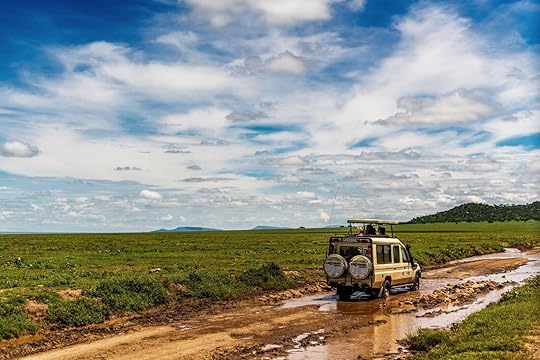
Tanzania’s parks have mostly unmarked dirt roads that could be hard for solo drivers to navigate. Photo: Jen Watson/Shutterstock
Our guide picked us up from our hotel in Arusha, the gateway city to the Serengeti, in a rugged-looking safari vehicle. It could seat seven, but since all Unforgettable Travel tours are private, my friend and I had the spacious car all to ourselves. It would be our home for the next week as we traveled more than 300 miles across the plains of the Serengeti.
Geoffrey, our guide, wasn’t a man so much as a wildlife encyclopedia. En route to Ngorongoro Crater, he rattled off interesting facts about the baboons on the roadside, and swiftly identified birds we’d never heard of. He answered every question I asked with confidence, even ridiculously stupid ones, like “If giraffes only eat plants, how do they get so tall?”
Smooth roads soon turned to bumpy gravel, then dirt. And it didn’t take long to make me happy we hadn’t opted for a full do-it-ourselves road trip, as it quickly became clear you shouldn’t go off-road driving on the unmarked roads and trails around Tanzania’s national parks. Away from the main roads, it was mostly dirt roads with no signs or markers whatsoever. It seemed like you’d just have to know where you were going. Technically, you’re allowed to drive yourself without a guide, but I’m not sure how anyone actually does it because it’s so easy to get lost. And since you need to make all your hotel and resort reservations in advance, you can’t just wing it to figure out where to stay based on how much distance you can cover each day — showing up to a safari camp without a reservation is not a great idea.
The drive took about four hours, passing Maasai villages on hillside as we skirted the crater’s rim. Eventually, we arrived at Entamanu Camp, our first hotel of the trip. Anyone thinking that safaris still mean camping in wind-rattled tents has never seen a place like Entamanu Camp. The cozy cottage felt like I was staying at a cousin’s lake house, if that lake house had near-panoramic views of the natural scenery. And this isn’t camp dining — the food was fantastic and we certainly didn’t go hungry.
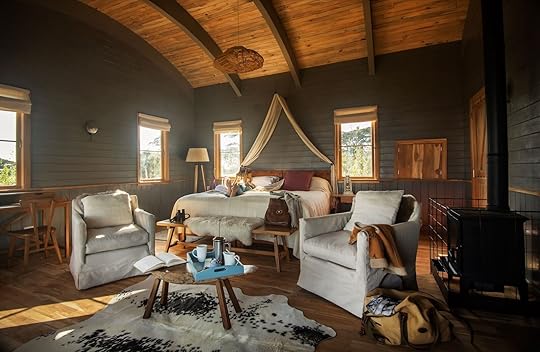
Photo: Entamanu Camp
“More steak?” the waiter asked us at dinner, when he noticed we’d devoured our steak tips in record time.
“Sure, why not?” we replied.
He gave us a knowing smile, disappeared into the kitchen, and returned 10 minutes later with a massive tray of steak fillets.
Praising a hotel’s hospitality has become cliche. They’re in the hospitality industry — of course they’re hospitable. But the team went above and beyond, and we joked that they felt like doting mothers trying to fatten you up with food and affection.
“You are welcome,” the staff say upon arrival, upon your return from safari, when you sit down to dinner, and pretty much whenever else they cross your path. It means, quite literally, “you are welcome here.”
Entamanu Camp, as well as the others we visited, are camps owned by Nomad, a safari company that partners with Unforgettable Travel. Between arriving at the camp and spending time with Geoffrey, it was clear after just one day that warmth and friendliness are two staples of the Nomad experience.
View this post on Instagram
A post shared by Eben Diskin (@ebenflow_)
Our first morning, we woke up bright and early – or, more accurately, dark and early, as our game drive began just before 6 AM. Ngorongoro Crater is the world’s largest intact volcanic caldera, and known by some as the “Eighth Wonder of the World.” It’s also a protected area within Tanzania, and a UNESCO World Heritage Site, and home to more 26,000 large mammals and 500 bird species.
If you’ve always wondered if The Lion King was based on a true story, visiting Ngorongoro will dispel any doubts. Zebras, elephants, rhinos, antelopes, and flamingos live alongside one another in relative harmony on the vast grasslands. Baboons make their home in the forest trees, while hippos lord over the lakes. And in true Lion King, it didn’t take long to witness a drama unfold between lions and hyenas as they vied for the same wildebeest kill.
As we watched the animals go by, I kept thinking that it felt like a Garden of Eden, but without the humans — which is probably for the best.
The southern Serengeti
Photo: Michal Hamet/Shutterstock
After visiting the Ngorongoro Conservation Area, safari-goers would typically fly from a nearby airstrip to somewhere within Serengeti National Park. But because we’d chosen to take a Tanzania road trip, we instead embarked on a five-hour road trip to the southern part of the Serengeti through a variety of diverse landscapes.
Leaving the Ngorongoro area, we passed through lush hills home to scores of Maasai villages. Maasai men worked in the fields, while women impressively balanced baskets of fruit on their heads. One school-aged girl, with elaborate handcrafted earrings and a bag slung across her back, walked through the tall grass between a group of giraffes and zebras, paying them no more attention than if they had been squirrels. This brief window into daily life in the Serengeti instantly made me thankful we had driven instead of flown.

The southern Serengeti is flatter and more open. Photo: nshah86/Shutterstock
A few more hours of bumping along under forested canopies and muddy plains, and we were knocking on the door of the southern part of the Serengeti. The plains are almost completely flat, with acacia trees dotting the misty horizon. The region’s famous wildebeest migration starts from this region in July, and it was only January, so there were still hundreds of wildebeests milling around in giant herds.
On the way, in one particularly muddy stretch, our car lurched and stopped, tires stuck in the mud. Looking ahead, we saw that rain from the night before was making the road ahead of us look a little dicey. But it was no problem for Geoffrey, who grabbed a machete from under his seat, and ran off to find an alternate path, in a truly Indiana Jones-esque move.
My friend and I poked our heads through the sunroof, and were astonished by the sheer flatness of the plains around us. We saw no mountains, no bodies of water, and no other cars in any direction. Just Geoffrey on a solitary trek through the tall grass and a distant herd of wildebeest, all marching single-file toward their next watering hole, their backs tinged orange by the setting sun.

Photo: Robert Harding Video/Shutterstock
Geoffrey eventually did find an alternate route, and we backed up, changed direction, and soon arrived at the Serengeti Safari Camp. Rooms at the resort are sturdy canvas tents without any frills or luxuries, but everything you need for a comfortable stay.
“You are welcome,” we heard again and again when we arrived. We would become quite close to the staff here, thanks to an innovative feat of bush engineering: the bucket shower. Because Serengeti Safari Camp is a mobile camp, moving with the wildebeest as they migrate, there’s no permanent plumbing. Instead, guests inform the staff when they’d like to shower, and a team member will fill a bucket with heated water, hoist it into position, and refill it as needed while you pull levers to activate the water flow. It’s not as weird as it sounds, though calling out instructions to a random guy while showering does take some getting used to.

Photo: Eben Diskin
Showers aside, everything in the tent is what you’d expect from a normal hotel room. My favorite part of staying at a rustic camp like this was feeling closer to nature. You can hear lions roaring in the night (hence the guards with spears who keep watch during the night), and we even saw an elephant casually stroll past the front opening of our tent. It was like a little amuse-bouche — a prelude to the safari to get us excited for what was to come.
“The animals always have their own story,” Geoffrey told us the next day on safari, as he stopped our vehicle beside a small pack of lions, feasting on a dead wildebeest. “You never know what they will be doing.”
Sure, Geoffrey was explaining to us why he loves his job — but it really did seem like he always knew what the animals would be doing.
“Watch the hyenas on the ridge,” he said. “They will wait for the lions to finish, then come in and finish the meat. They are scavengers.”
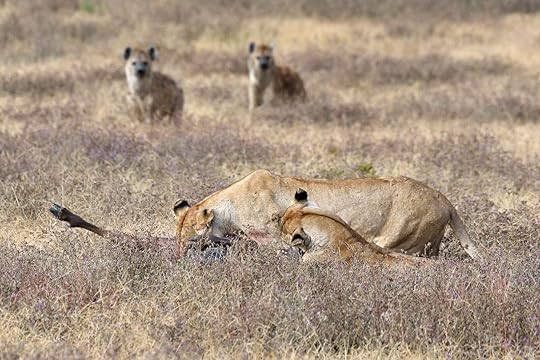
Hyenas watching a lion with a kill in Tanzania. Photo: Vladimir Strnad/Shutterstock
Sure enough, the hyenas eyed the lions below, waiting somewhat impatiently for them to fill their bellies. There were four lions, and about seven hyenas.
“Will they attack?” I asked, eager for some action.
“They are thinking about it,” Geoffrey answered, “but probably not. There are too few of them, and too many lions.”
For at least 45 minutes we watched the scene unfold, lions feasting on the wildebeest while the hyenas circled and waited. Eventually the lions cleared out, and as Geoffrey had predicted, the hyenas descended on the remains.
Watching lions eat a wildebeest might not sound too thrilling, but the social dynamics at play – between the lions and hyenas, and within the groups themselves – were fascinating. We hadn’t exactly witnessed a Lion King-esque war between lions and hyenas, but it still felt like we’d been privy to something special.
Driving to the northern Serengeti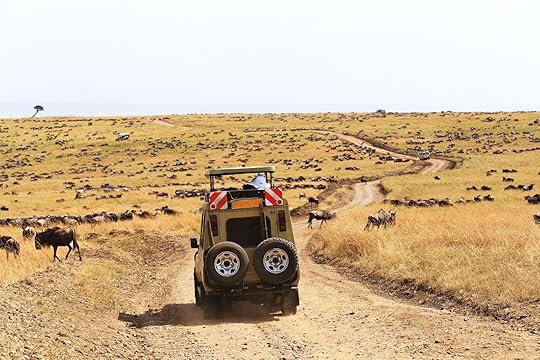
A Tanzania road trip through the northern Serengeti. Photo: padchas/Shutterstock
Two bucket showers later, we started our long drive to the Northern Serengeti. The safari vehicle had become our home away from home, more so than the camps. Nomad had stocked it with a cooler containing our drinks of choice (orange juice and Coke Zero), as well as Pringle containers that were vanishing quicker than a zebra being devoured by a pack of hyenas.
Thanks to these little luxuries, the six-plus hour drive north through the mountains felt more like traveling in a mobile apartment than a cramped car. It also helped that Nomad provided picnic lunches and breakfasts for our days on the road, or while we were on safari. The breakfasts were particularly sumptuous, and in the mornings, we’d stop at picnic sites with fabulous Serengeti views to dig into the overpacked boxes.
The drive necessitated a lengthy climb over the mountains, down uneven crags, and through muddy fields, all of which Geoffrey was able to navigate far better than I would have. Eventually, we entered the Northern Serengeti, and the landscape changed. Endless flatlands were exchanged for hills covered in tall grass, and rock formations resembling Pride Rock dotted the area.
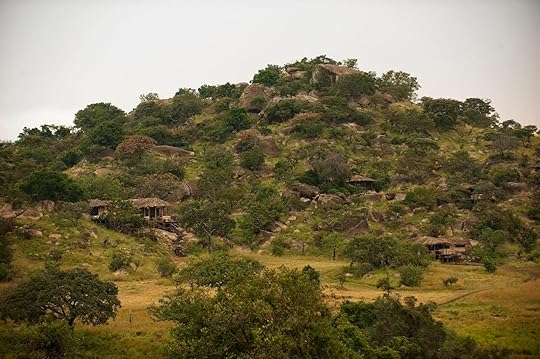
Photo: Lamai Camp
Lamai Camp is a masterclass in architecture, sitting atop a hill overlooking the northern Serengeti. On arrival, we were led down a tree-lined dirt path to a Maasai-inspired building that revealed panoramic views of the Serengeti and Mara River as we walked further in. This main building and the camp rooms were built with locally sourced materials using methods unique and authentic to Maasai tradition. The main building and cottages feel both luxurious and organic, achieving an aesthetic authentic to the area’s Maasai roots.
Technically, you could get the experience of being on safari just by sitting on your private wrap-around porch. I could have spent all day overlooking the plains, spotting elephants breaking down tree branches with their trunks, baboons chattering in the brush, and wildebeests marching toward the river. But without Geoffrey, our private wildlife encyclopedia, much would have been missed.
Most notably, while driving through a field of antelopes, a bird call rang out from somewhere in the trees, and Geoffrey abruptly stopped the car.
“Watch,” he said. “The bird is alerting the antelopes that there is a predator close by. Maybe a leopard.”
The herd of antelopes stood at attention, watching the grass silently, fearfully. All at once, they suddenly bounded away for higher ground.
“See? In the grass?”
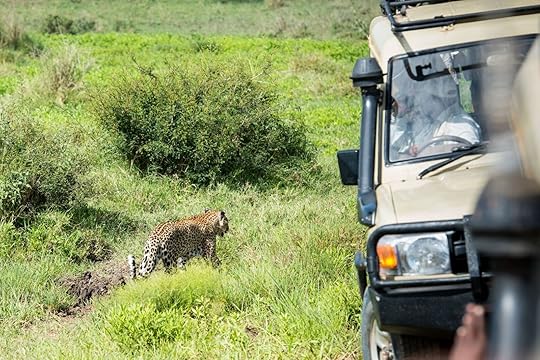
Photo: Ilyas Kalimullin/Shutterstock
Sure enough, a leopard lay in the grass. Foiled in his pursuit by the bird call, it slinked away to find other prey. It was yet another example not only of Geoffrey’s impressive knowledge, but of the subtle dramas playing out between the animals all around us, and the way they communicate and collaborate much as humans do.
The last leg of our Tanzania road trip actually wasn’t on the road — we took a two-hour bush plane flight from a nearby airstrip to Arusha for our international flight home. It was fascinating to have a bird’s-eye view of the sprawling landscape, but also made me thankful for spending the last week on the ground, getting a slower, more in-depth look at the landscapes, towns, valleys, and rolling hills of the Serengeti. Yes, driving was slower, and it’s easy to get impatient. But it’s also a chance to experience the full range of the Serengeti — not just for its myriad flora and fauna, but for its muddy roads, mountain passes, lush forests, and small, traditional communities.
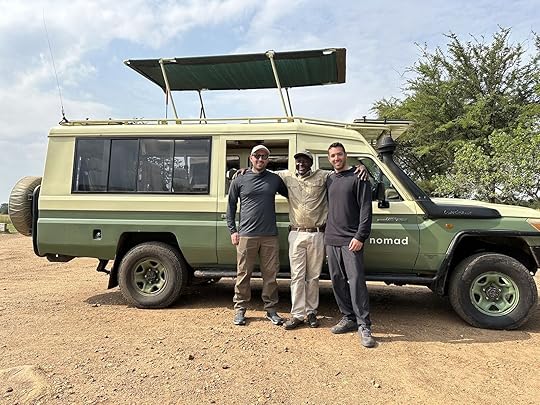
The author with his travel companion and guide. Photo: Eben Diskin
Saying goodbye to Geoffrey on the landing strip felt surreal. He had been our window into the complexities of the animal kingdom for the last week, and guided us safely and skillfully across dicey roads and terrain. He’d also put up with our loud American humor and entertained our stupid questions, always with a genuine smile on his face. It felt surprisingly sad to say goodbye to him after how much we’d come to enjoy and appreciate him over the last week. How do you say goodbye to someone like that, knowing you’ll likely never see him again?
“I’ll admit, at first I didn’t want a guide at all,” I told him. “I was worried we’d feel like spectators at a zoo, and it wouldn’t be authentic. But you gave us the best of both worlds – like we were actually part of the animal kingdom. Thank you.”
Ever shy, Geoffrey just looked at the plane, then back at us, and hugged us both.
“You are welcome,” he said. 
Matador Network's Blog
- Matador Network's profile
- 6 followers



